



















The Czech Chamber of Deputies has approved a sweeping reform of the country’s criminal code, paving the way for more lenient cannabis laws and a shift toward alternative sentencing.
The bill, passed by 142 of 159 MPs present, marks one of the most significant updates to Czech criminal law in decades, aimed at reducing prison populations and promoting rehabilitation over incarceration.The reform, which still requires Senate approval, is set to take effect from January 2026.
One of the key aspects of the reform is the easing of restrictions on cannabis possession and cultivation. Under the proposed rules, individuals will be allowed to grow up to three cannabis plants for personal use, and to possess up to 100 grams of dried cannabis at home or 25 grams in public.
Possession beyond these limits would still be penalized, with growing four to five plants classified as a misdemeanor, and larger amounts treated as a criminal offense. Possessing over 200 grams of dried cannabis at home would also be considered a felony.
The new framework, introduced by MP Zdenka
Němečková Crkvenjaš, represents a compromise after more ambitious proposals from the Pirate Party to create a regulated cannabis market were rejected.
The changes also include the creation of a dedicated section in the penal code for cannabis-related offenses, with penalties calibrated to reflect the lower societal risk of cannabis compared to other drugs.
Justice Minister Pavel Blažek, who has resigned from office in the wake of a Bitcoin scandal, said the broader reform aims to distinguish between truly harmful conduct and minor infractions that need not burden the criminal justice system. The amendment on cannabis has drawn attention from both supporters of drug policy liberalization and those who warn against normalizing drug use.
To recap, here is what was approved:
• People over 21 years of age will be allowed to grow up to 3 cannabis plants per household.
• Possession of up to 100 grams of dried flower at home and 25 grams in public will be legal.
• Possession of up to 200 grams of cannabis will be treated as a misdemeanor, while possession of more than 200 grams will be considered a criminal offense. Penalties will depend on the amount of cannabis held, starting with a suspended sentence.
Altough Czech cannabis activists hoped for at least 300 grams for personal possession, it is still a huge step forward for the cannabis community in the Czech Republic and across Europe.
The approved legalization model in Czechia involves a possession limit that is considerably greater than in other legalized European countries. Malta became the first country to legalize cannabis for adult use in 2021. Adult households in Malta can cultivate up to 4 plants in private, and adults can possess up to 50 grams of cannabis.
In Luxembourg, where lawmakers adopted a national cannabis reform measure in 2023, adult households can cultivate up to 4 plants in private, but possess just three grams of cannabis. Germany, which legalized cannabis for adult use in 2024, allows adults to cultivate up to three plants in private residences and possess up to 50 grams of cannabis.





















Page 10
Biscotti
All brilliant things come in threes
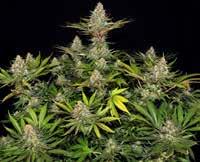
Page 12
Clonex
Hormones for rooting and much more Page 20
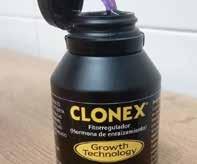
Page 14 Cold Cure Tech How to cure Fresh Frozen Water Hash

Ganja Paradise, part 2 Marijuana Cultivation in Thailand Page 26
Wernard Bruining, the Potfather First coffeeshop, first grow shop and founder of Soft Secrets!



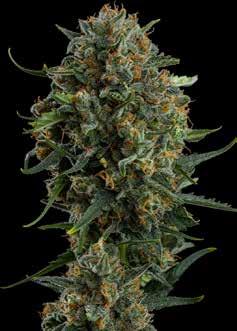




Foto's:
Derrick Bergman
The famous HighLife Cup in the Netherlands celebrated its 31st edition last June. As one of the oldest cannabis cups in the world, the HighLife Cup (organized by the people behind Soft Secrets) is one of the leading cups in Europe. Here are the results!
INDICA DOMINANT
1 Zowanami | Dizzy Duck, The Hague | 330,1
2 Red Red Wine | Club Animo, Gouda | 325,9
3 Dreams Gold | Relax Zuid, Amsterdam | 324,8
SATIVA DOMINANT
1 Zprite | Meetpoint, Den Bosch | 313,3
2 Doctor Haze | Coffeeshop Fly, The Hague | 309,7
3 Tropicana Cherry | De Ambassade, Zwijndrecht | 309,4
OLDSKOOL
1 Super Silver Haze | Hunter's Coffeeshop, Amsterdam | 321,3
2 Chemdawg x Tangie | Dizzy Duck Downtown, The Hague | 311,5
3 Dreamsgold | Empire, Haarlem | 311,1
IMPORT USA
1 Gelonade | Coffeeshop Solo, Amsterdam | 312,3
2 Zowahh | Dizzy Duck Downtown, The Hague | 311,7
3 Super Buff Cherry | Genesis, Geleen | 307,4
US STRAINS GROWN IN EUROPE
1 Apple Banana Ice | Coffeeshop Marbella, The Hague | 331
2 Subzero | Genesis, Geleen | 324,6
3 Bio Pinata | Dizzy Duck, The Hague | 320 OUTDOOR
1 Sour Dreams | Empire, Haarlem | 286,5
2 Skunk XL | Genesis, Geleen | 261,5
3 Passion #1 | Dutch Passion | 259,5
HOUSE SPECIALTY
1 Tropicana Cherry | Coffeeshop Marbella, The Hague | 329,9
2 Sunsetz | Dizzy Duck Downtown, The Hague | 318,2
3 Cherry Grapefruit | Club Animo, Gouda | 311,6
SEED BANKS – INDICA DOMINANT
1 Slush Mint Cake | Dutch Passion | 302,5
2 Pink Glitter Bomb | Growers Choice | 286,7
3 Granny's Home | Seed Stockers | 282
SEED BANKS – SATIVA DOMINANT
1 Mimosa | Royal Queen Seeds | 299,4
2 Girl Scout Cookies | Dutch Seed Farmers | 294
3 White Haze | Sensi Seeds | 293,6
SEED BANKS – OUTDOOR
1 Rucu Cucu | Seedstockers | 312,7
2 Tangie | Royal Queen Seeds | 309,8
3 Auto Cinderella Yack | Dutch Passion | 282,8
SEED BANKS– AUTO FLOWER
1 NYC Diesel Auto | Royal Queen Seeds | 284,2
2 Auto Frozen Biscotti | Dutch Passion | 278,7
3 Tropical Zmoothie Auto | Seedstockers | 269,4
CUP 2025
RUCU CUCU | SEEDSTOCKERS (Highest THC) POTENCY CUP 2025 Hashisch: LEMON CHERRY GELATO | COFFEESHOP FLY (Highest THC)
Results Hashish:
OLDSKOOL HASHISH
1 Shaher Beldia | Coffeeshop Magic, The Hague | 279,6
2 Banana OG | Barney's Coffeeshop, Amsterdam | 275,8
3 King Hassan Primero | Cremers, The Hague | 266,8
MODERN HASHISH
1 Mela Verde | Club Media, Amsterdam | 293,5
2 Pistacho | Coffeeshop Solo, Amsterdam | 289,5
3 Melonatta x Gelato 41 | Coffeeshop Fly, The Hague | 285,4
HOUSE SPECIALTY HASHISH
1 Forbidden Fruit Calippo | Dizzy Duck, The Hague | 296,7
2 Mandarim Jam | Club Media, Amsterdam | 273,7
3 Dosidos | Coffeeshop Solo | Amsterdam 273,5
HASHISH SPECIAL
1 Fruit Joy | Dizzy Duck, The Hague | 320,5
2 Nam Wah | Coffeeshop Solo, Amsterdam | 309,2
3 Lemon Cherry Gelato | Coffeeshop Fly, The Hague | 284,8




HIGHLIFE CUP 2025 MARIJUANA: APPLE BANANA ICE | COFFEESHOP MARBELLA , THE HAGUE
HIGHLIFE CUP 2025 HASHISH: FRUIT JOY | DIZZY DUCK , THE HAGUE
The FFX Hemp Grinder by FIRE-FLOW stands out with its bold design and sustainable materials.
The provocative artwork, known from the popular Clipper lighters, gives your grinder a unique and recognizable look. Show what matters to you – with a grinder that not only works, but also has personality. A reliable tool for those who value quality and want to make a clear design statement. www.fire-flow.eu







Say hello to ATAMI new VGN - VEGANIC
VGN fertilizers are the result of transforming plant waste into solutions for your plants. With these liquid fertilisers you nourish the plants while supporting beneficial soil micro-organisms. Also, VGN products are certified for organic farming by Control Union.
Discover:
• VGN 5-2-2: Nitrogen for greener, healthier plants.
• VGN 2-2-4: Potassium for stronger, more robust plants.
• VGN 1-4-4: Phosphorus & Potassium for rich flowering.
• VGN CALMAG: VEGANIC calcium & magnesium supplement.
Combine and adapt them to the needs of your plant!
Find the VGN line soon in your nearest store and taste and feel the difference! e-mail: info@wilmalg.de - support@wilmalg.de.





This is a rather small plant, although highly branched and with short internodal spacing due to its indica tendency (around 70%). It has a very resistant structure, offering high-quality flowers with a great terpene profile, very compact, and a large amount of trichomes per square centimeter. Beneath its sweet and creamy nuances, reminiscent of vanilla, with citrus and tropical touches, we find high THC content, which guarantees 28% THC and medium levels of CBD, which translates into a very intense and long-lasting cerebral and physical effect. This strain is ready for harvest between 67 and 70 days in indoor cultivation and mid-September in outdoor cultivation.
The high offered by this strain is very intense due to the Indica tendency, which is present at 70/30, producing a very intense and rapid cerebral effect.

Zerealz Milk seeds are very homogeneous at first glance, which makes this strain a good candidate for SOG cultivation due to the expected uniformity of growth. Germination took place in a Petri dish as usual. 24 hours after germination, the shells of the three seeds sent to us were opened. After 72 hours of plant life, the plants showed a marked vitality, making their way
through the substrate, this time using a mixture of organic compounds based on guano, epsomite, phosphorite, bokashi, and ash, mixed with a little organic substrate to promote good growth and the desired texture for our cannabis plants.
We started watering with an organic root stimulant dissolved in water, administering
around 250 ml of liquid per 7-liter pot. After the first week of life, the cotyledons were about 4 centimeters long and had a couple of leaves pushing through the substrate, as usual, indicating that this genetic material is healthy. The following week, we replaced the rooting solution with water and organic fertilizer (1 ml of fertilizer per 2 liters of water), creating an easily assimilated solution with all the nutrients, acids, and enzymes it needs to thrive, as its root system is still developing. Finally, once the roots are more colonized, we increased the dosage to 350 ml of solution per plant and moved the LED plant closer to about 50 centimeters to stimulate the Zerealz Milk and ensure uninterrupted growth. Now only the last few weeks of growth remain, which indicates that the next step is to change the light cycle from 18 to 12 hours of constant light.

In the following weeks of life, the plants are induced to a 12-hour light cycle and the LED distance is adjusted, giving way to the first signs of pre-flowering, for example, the appearance of the first clear signs of the plant's pre-flowering stage, followed by the massive proliferation of pistils, revealing some terpene nuances that this cannabis plant will offer us in the future. Another important nuance to highlight, despite being an early stage for maturation, is the quantity of trichomes it produces, which are fine, very clear, and sticky in appearance.
Growing parameters also evolve alongside the plant, increasing the dosage of phosphorus and potassium to promote optimal flowering and increase bud mass. This increase represents 10% of the initial dose, as the flowers were beginning to show very subtle signs of deficiencies in some elements. The flowers of this strain are gradually becoming considerably harder, despite their not being extremely large.
Over the last two weeks, we performed an intensive root flush, as this process is crucial
for removing excess salt or accumulations of fertilizer and other compounds that can create deposits in the substrate. This is a very helpful method for the plant. In this final phase, the pistils begin to oxidize, and they take on an ochre hue. The nuances have completely changed, with strong lactic and berry notes now perceptible. Finally, we must mention the hardness of these flowers, as despite their medium-sized size, they are very hard and shiny, with very few nooks and crannies.
As expected, this strain met our expectations, guaranteeing full flowering in approximately 63 days, producing dense, sticky, and trichome-filled flowers ready to be harvested. This strain has very dense, trichome-filled flowers with hints of freshwater fruit. Harvesting was easy due to the compactness of the plants and their flowers, yielding an average of about 30g per plant when dry. During drying, we used a plastic net to place our flowers vertically for the first phase of drying. After two weeks hanging on the net, slight discoloration and reduction in size can be seen due to water evaporation. Finally, once the flowers are at their optimal drying point, we place them in airtight jars, so that the nuances in the flowers are fixed and all their organoleptic properties are developed. In them we can appreciate nuances of forest fruit, a strong lactic smell and a little acidity in the background.
In beautiful Cape Town, there's room for a business that has successfully combined botanical passion, foresight, and openness to an international audience of tourists and cannabis enthusiasts: Rooftop 420, a chain of stores aiming to combine quality products with a relaxed, convivial atmosphere where anyone can find the ideal conditions for consuming high quality cannabis. Today, we're honored to speak with Paul Mavrocoleas, the co-owner of this South African brand in Cape Town...
When and why did you launch Rooftop 420?
Rooftop 420 was born in September 2023 in Cape Town, sparked by a shared vision amongst myself and the co- owner to create a premium cannabis experience. We started humbly with a small shop in Wynberg, driven by a passion to redefine cannabis culture with quality, consistency and community at its core.
Cape Town Store Finder
What’s the philosophy behind Rooftop 420?
Our philosophy is simple: deliver premium products, exceptional service, and a welcoming atmosphere. Consistency is our


cornerstone, alongside fostering a tightknit community. We aim to provide top-tier cannabis solutions, create a safe space







for patrons to enjoy, and educate about cannabis. Our products speak for themselves, reflecting our commitment to quality, consistency and inclusivity.
How many stores have you opened in South Africa, and what values guide your brand?
We’ve grown to 10 stores across Cape Town, each embodying our core values of consistency, ethical practices, and inclusivity. We strive to create spaces where everyone feels welcome, ensuring a reliable and high-quality experience at every location. We are currently opening our 11th store which will be our first full Medical grade Pharmacy, Alterpharm.
Why is South Africa a must-visit for cannabis enthusiasts?
South Africa is a cannabis lover’s paradise, offering premium, diverse products and a vibrant culture. With stunning outdoor activities to complement your experience and our unique cannabis clubs as cultural hubs, visitors can relax and immerse themselves in a rich, welcoming community.
Tell us about your premium products—what are the most
popular, and which ones are you proudest of?
Our premium range is crafted to impress, with standout strains and innovative products that consistently top our customers’ lists. We take pride in our meticulously sourced cannabis, which reflects our dedication to quality and innovation—each product is a testament to our passion for excellence. Our Edibles and Extracts are produced in a licensed laboratory which further adds to our commitment of quality and consistency.
How does your membership policy work for tourists?
Joining Rooftop 420 is seamless for tourists. Simply visit with a valid ID or passport, and our friendly, knowledgeable staff will guide you through a quick sign-up process. We make it effortless to become part of our community, ensuring an informative and welcoming experience.
What’s next for Rooftop 420?
We're expanding Rooftop 420 in South Africa and beyond, integrating Alter Pharm, our licensed medical pharmacy, into select locations. Members will access prescription medications, medical-grade cannabis, and wellness products in a safe, welcoming environment. This hybrid model combines recreation, wellness, and medical care, shaping the future of South African cannabis culture. We're also enhancing events, community ties, and responsible cannabis innovation… and of course Good Vibes!













ww.rooftop420ct.co.za



Outdoor 2025
Stoney Tark
You will fill your pots with the growing medium, which the roots will grow into and source their food. Picking the right growing medium should not be rushed; ensuring it has all the right properties is key.
My tip is to make sure the medium has good drainage, water retention, and lots of air pockets inside. It should also ideally contain all the nutrients your plants need to grow from seed to harvest. Making your own custom mix is always a great option, so consider using coco coir, worm castings, compost, and soil mixed with perlite and vermiculite for the ultimate growing medium.
If you want to get the best yields outdoors, the easiest way is to apply plant training techniques during the vegetative stage. There are many different ways to train an outdoor cannabis plant, including topping, fimming, tying down, super cropping, and pruning.
My tip is to train them only from May until July and then avoid any training techniques once the plants start flowering. Some highstress methods can harm the plants more than good once they grow buds and may result in stunted plants, hermaphrodites, and significantly lower yields.
Watering cannabis plants is how the roots access oxygen and available nutrients, either from the soil or from a nutrient solution. Overwatering a cannabis plant will not do the plant any favours and can cause the growing medium to become heavy, creating a low-oxygen environment and producing harmful aerobic bacteria that attack the roots.
My tip here is to lightly water the plants around your pot's edges and let the growing medium absorb the water. Do not assume that the more water your plants get, the bigger they grow. Remember, less is more when it comes to watering cannabis. Ensure your growing medium has plenty of air pockets and contains a high volume of perlite to help speed up the drying-out process between watering.
Hot soil simply means that the soil contains too many nutrients that can harm seedlings. When you go to the local garden centre, there will be a wide range of soils on offer.
Some soils will be packed with high levels of nitrogen, phosphorus and potassium, and some may even contain chemical nutrients.
When purchasing soil for your outdoor project, always check the labels to see the nutrient ratio and whether it contains chemicals. My tip is to avoid anything with an N-P-K ratio of 20-20-20, and if you can, just make your own custom soil mixes. It is best to use a light potting mix for seedlings and then be prepared to repot them later on, or supplement them with liquid nutrients if you think the soil is over-fertilised.
You may be tempted to use the same pots you have had lying around in your garden for this year's outdoor grow. However, plastic pots are not the best for growing cannabis. Plastic pots cause roots to become rootbound, limiting the root mass and height of the plants.
My tip here is to use either air pots or fabric pots, as these provide plenty of oxygen to the root zone, encourage the roots to prune themselves and eliminate the concern of a root-bound cannabis plant that will need constant repotting. Even though air pots and felt pots can be expensive, they are worth the investment and will produce the bestlooking plants and potential yields.
Multiple Harvests with Autos
If you do not have the space in your garden

It's that time of year again, and your chance to cultivate some outdoor high-grade cannabis. If you are new to growing cannabis, this article will provide my top tips to take your outdoor growing skills to the next level!
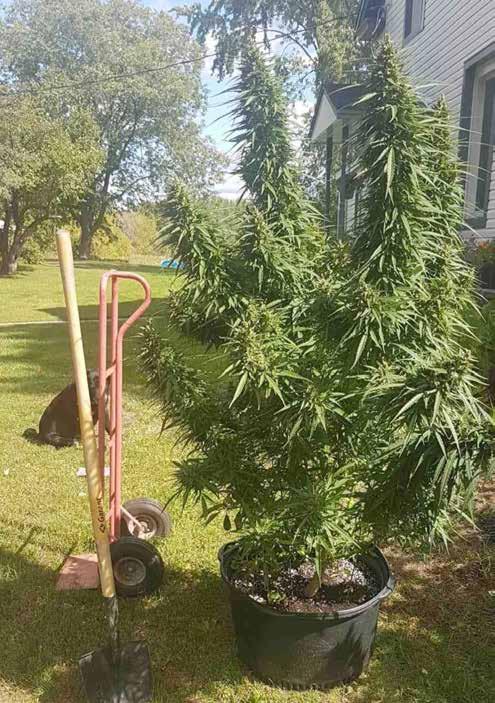
to grow a large-sized photoperiod strain or are too impatient to wait until the end of September or mid-November to harvest, why not try auto-flowering cannabis strains? Autos are sturdy and tough plants that will flower automatically after 28 days of vegetation and grow between 75 and 100 centimetres in height.
My tip here is to try planting autos. Autos allow you to produce back-to-back harvests from May until late September. They are also an excellent way to create a stealthy and dis-
creet garden and allow you to harvest many different flavours and effects over the year.
Growing cannabis outdoors is a great learning experience and a way to discover how cannabis plants adapt to sunlight. Ensuring you have the best possible growing medium and plant watering schedule, and working with fast-flowering or auto-flowering cannabis strains will provide the best results, especially in Northern Europe.
Choosing the right fertilizer is crucial for cannabis cultivation, impacting yield, quality and overall plant health. Among the options available, liquid fertilizers and soluble dry fertilizers are popular choices. Each has its advantages and drawbacks. Understanding these can help growers make informed decisions tailored to their specific needs.
Liquid fertilizers provide a range of benefits that make them a preferred choice for many growers. One of the primary advantages is convenience. Liquid fertilizers come pre-mixed and ready to use, requiring only dilution before application. This ease of use translates to significant labor savings,
Soluble dry fertilizers have gained popularity in recent years, particularly for their (perceived) cost-effectiveness. These fertilizers are typically cheaper to purchase initially and have lower shipping costs due to their concentrated form. They also require less storage space, making them an attractive option for growers with limited storage capacity.
One of the main advantages of soluble dry fertilizers is their potential for a longer shelf life, when stored properly! This can be beneficial for growers who need to stockpile fertilizers for extended periods. Additionally, soluble fertilizers offer flexibility in terms of customization. Growers can mix specific nutrient blends tailo-

as there is no need for extensive mixing or handling of dry powders.
Consistency is another key benefit. Liquid fertilizers are homogenous, ensuring an even distribution of nutrients. This uniformity leads to more predictable and reliable plant growth. Additionally, liquid fertilizers are easier for plants to absorb, enhancing their effectiveness. The better solvability of liquid fertilizers means they dissolve more readily in water, facilitating efficient nutrient uptake through roots or leaves.
However, liquid fertilizers do come with some considerations. They generally have a slightly higher purchase price compared to soluble fertilizers. Additionally, they require more storage space and have additional shipping costs due to their weight and volume. Despite these factors, the long-term benefits and ease of use often justify the investment. Barely any additional equipment is required.
red to their plants' needs, allowing for precise control over nutrient composition when the elements can be mixed separately.
However, soluble dry fertilizers also present some challenges. They require more labor and equipment to prepare, as they need to be dissolved in water to create a stock solution before application. This process can be time-consuming and may require additional tools such as mixers and storage tanks. There is also a risk of inconsistencies in nutrient distribution if the dry fertilizer is not thoroughly mixed, potentially leading to uneven plant growth. Taking scoops from a blend will lead to inconsistency per scoop for instance.
Another consideration is the potential for caking or clumping of dry fertilizers, which can make them difficult to dissolve and create sediment in tanks. This can result in blockages in irrigation systems and pipes, leading to inconsistent water and fertilizer distribution.

To mitigate these issues, it is essential to use high-quality soluble fertilizers and follow proper mixing procedures.
When deciding between liquid and soluble dry fertilizers, growers should consider their specific needs and circumstances. Liquid fertilizers offer convenience, consistency and less mistakes, making them an excellent choice for growers prioritizing ease of use and reliable results. On the other hand, soluble dry fertilizers provide cost-effectiveness when
purchasing and potential flexibility, appealing to growers with budget constraints and specific nutrient requirements.
Ultimately, the choice between liquid and soluble dry fertilizers depends on a variety of factors, including labor availability, storage capacity and budget considerations. By carefully evaluating these factors and understanding the pros and cons of each option, growers can make informed decisions that support the health and productivity of their cannabis crops.
Absorption
Customisation
Initial cost
Storage & transport
Shelf life
stable over time
– you can mix your own blends
and easy to store
if stored well
Dosage errors Rare - already homogenised More likely if not mixed thoroughly
Best for... Those who want ease & Those seeking savings & control
Pro tip: If you’re just starting out or want a hassle-free approach, go with liquids. If you enjoy experimenting and have time to manage the process, solubles give you more freedom.
Words & Pics: Green Born Identity – G.B.I.
If Gelato, Girl Scout Cookies and OG Kush get united at a genetic pinnacle meeting and amalgamated into a new strain, the outcome simply will have to be spectacular, as each of these three varieties is a class all by itself, highly coveted for many years by growers and users all around the world. In their capacity as renowned experts for top-notch West Coast genetics, the Barney’s Farm breeders created a mega plant from these three ace strains, their version of the popular ‘Biscotti’ strain concept. The BF twist on Biscotti - the indica/sativa ratio of which is 80:20 - boasts many superb characteristics: For instance, a fantastic multi-faceted aroma that according to Barney’s Farm appears to the nose as a ‘symphony of natural aromas’ – a blend of sweet, earthy and lemony notes makes for a pastry-like scent and taste. In the psychoactivity department, Biscotti has a lot to offer as well, with its high THC count of 25-27% effecting a strong long-lasting buzz experience that is characterised by a peaceful calm and deep relaxation, at the same time provoking a wave of euphoria. After a flowering time of 65-70 days, growers receive a rich dry flower reward of up to 650 grams per sqm. Bis-
light, Biscotti turns ripe in the second to third week of October.
Fast, lush growth following upon immaculate germination
Once again it was no one less than the living grower legend The Doc who decided to examine the quality of Barney’s Farm Biscotti version. After a three days picture-book germination (The Doc is so much used to with BF strains), the two seedlings set out on their cultivation journey. They showed a vigorous development, growing many strong lateral branches which gave them a bushy, very compact stature. As The Doc switched them into blooming three weeks after germination, the two plants stood 28 and 31 cm tall.
Voluminous
The Doc was very impressed by the plants’ shade leaves as big as dining plates, but most of them had to go when flowering set in, because they entirely overshadowed the lateral branches and would have hampered flower formation there. Four weeks into flowering, he
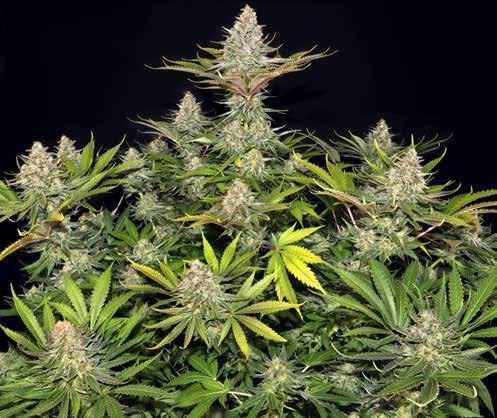
metres, cultivators may harvest of up to 1.5 kilograms each! Under natural
reported “these two plants are bursting with strength! Although they’ve energetically stretched out during the first four weeks of flowering, they’re still pretty compact, equipped with a very solid scaffold of branches. Flower cluster formation has quickly gained momentum, and
as early as now, there’s a goodly trichome frost on the young buds to be marvelled at! While this is a standard to me with BF varieties meanwhile, it’s nonetheless fascinating and lovely to look at every time anew.” Likewise fascinating was the further progress made by The Doc’s
flower show! Rock-solid voluminous fat buds galore on both plants, and just as supposed, they’ve become insanely resinous, with the trichome frost reaching down to the smallest of buds, it’s a stunning vision in white, the biggest buds are looking like sugarloafs! Of
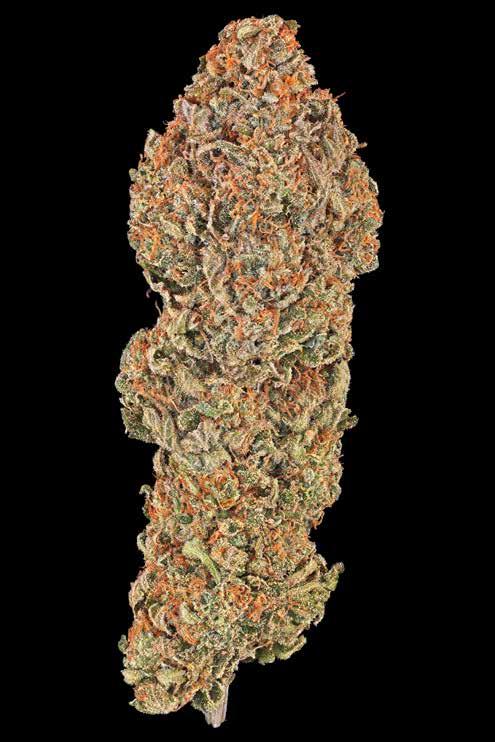
two Biscotti plants – they developed a plethora of gorgeous buds that became increasingly big, dense and rich in trichomes – in a word, increasingly breathtaking! Enthused The Doc when the end was in sight after a bit more than 60 days: “It’s a true gala
course though much too good for a Feuerzangenbowle (a flaming German rum punch)…”, he joked, and added “the flower scent is a bewitching olfactory sensation, boasting a delicious complexity, so sweet I almost cannot take my nose off these buds. Everything mentioned by
Barney’s is in there – an intense sweetness undercut with both an earthy-woodsy and citrusy note, plus a hint of black pepper.”
To create and finish this grandeur, the two Biscottis even didn’t have to go the max – after 65 and 67 days already, The Doc considered them fully ripe. And so he harvested the two, at final heights of 68 and 75 cm.
An ample yield: Even above The Doc‘s high standard
Weighing the dried and cured buds 3.5 weeks later brought a final result to light that even surpassed The Doc’s high yield standards:
Ample 135 and 144 grams he happily pocketed off his two Biscotti plants. Richly glinting with crystals, the big Biscotti buds, as hard as a board, were a feast for the eyes. And for The Doc’s sense of smell, they were a feast as well:
“While the flowers had been smelling highly sweet already before, they’ve even added an extra scoop of sweetness to their scent in dried and cured state now, and in combination with pungent notes of pine, clove and a bit of citrus fruit, their fragrance somewhat reminds of Christmas cookies with citron.”
A journey into the realms of blissful deep relaxation…
So The Doc‘s first Biscotti sampling session promised to be a flavour highlight, and his high expectations were not disappointed when he took a first hit off his Venty Vaporizer: “On the
inhale, my taste buds sent a signal of exceptional weed sweetness to my brain, and the aftertaste had those spicy Biscotti aspects also unfold on my palate then, piney, clovey and slightly peppery – what a delish taste!” Then
The Doc quickly went on a journey into the realms of blissful relaxation… with three hits down his lungs, a feeling creeped over him as if his head and body got stuffed with cotton wool, that strong was the relaxing buzz caused by Biscotti. It wasn’t a leaden heaviness, but quite the opposite – it promoted a sensation of lightness and easiness that went along with a bright mood-enhancing effect – “Biscotti delivered a wonderful wellness package lasting way more than two hours, perfect for unwinding after a long working day and highly compatible with watching TV, with no fatigue at all”, reported a super happy Dockie afterwards.
Said The Doc in conclusion, “with Biscotti, Barney’s Farm has brought out another sensational strain stunner! All brilliant things come in threes – the amalgamation of Gelato, Girl Scout Cookies and OG Kush has led to the rise of new cannabis magic. This variety has left me completely enthralled, and I strongly guess any other grower trying this one will feel the same.”
Green Born Identity – G.B.I.
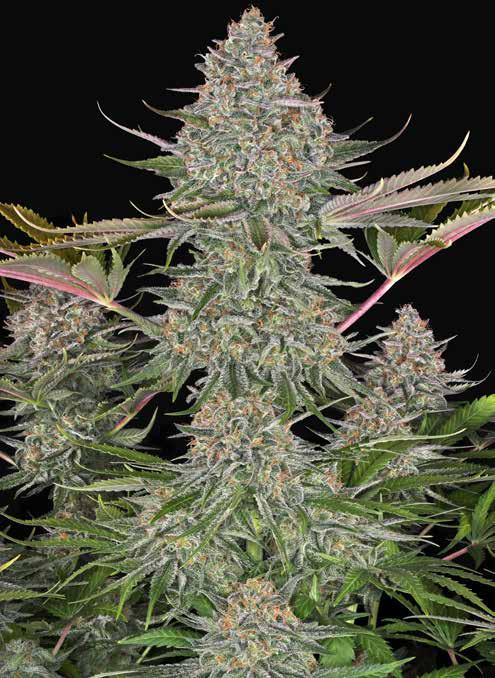
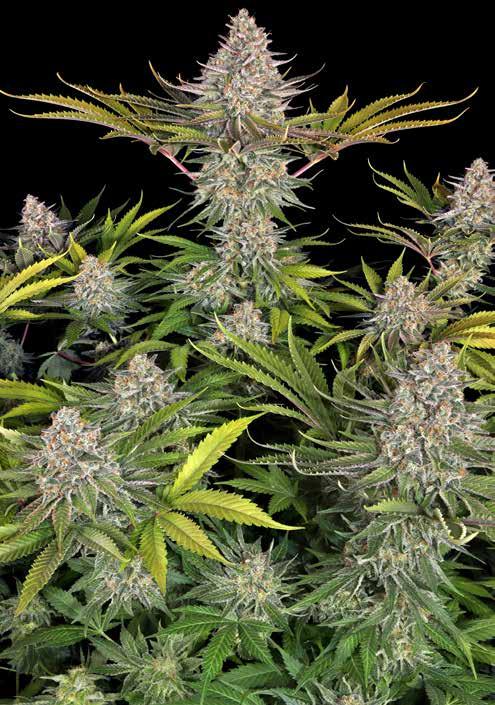
Genetics Biscotti (Gelato
Vegetative stage 21 days (after germination)
Flowering stage 65 + 67 days / 65-70 days in general
Medium Bionova Bio Soilmix, 11 litre pots
pH 6.4-6.7
EC 1.2-1.6 mS
Light up to 4 x SANlight EVO 5-100, switched to level 2 out of 3
Temperature 19-27°C
Air humidity 40-60%
Watering manually
Fertilisation Bionova Soil Supermix, plus PK 13-14 in the flowering stage
Additives/stimulants Bionova Silution, The Missing Link, Vitasol and X-cel
Tools CleanLight Pro for mould prevention
Height 68 + 75 cm
Yield 135 + 144 g
By Gerismit | gerard.7000b@gmail.com
Clonex is a key product for producing cuttings and it is making this widespread practice easier, safer and more productive. It allows you to reproduce selected clones from a mother plant and thus continue to reproduce the genetic lineage.

Clonex is a rooting gel focused on the healing process of cuttings, using a combination of hormones, nutrients, fungicides, and vitamins. It not only creates a healing effect on the plant but also provides the necessary elements for its optimal development. Clonex has been a consistent and effective product since the 1980s. Clonex has been a leading brand in the rooting gel market, with millions of growers using its products for decades.
The first known use of phytohormones dates back to before the Roman Empire, when farmers in the Middle East discovered that applying a drop of olive oil to figs promoted ripening. Today, we know that ethylene was the element responsible for promoting and accelerating fig ripening.
Later, around the 19th century, several studies conducted by Charles Darwin and colleagues demonstrated that plant growth is regulated
Like cytokinins, these are also key to the maturation and flowering processes in cannabis, in addition to promoting germination and the elongation of different stems.
This gas promotes and develops roots and shoots, in addition to playing a key role in regulating fruit ripeness and in the response and recovery from pathogen stress. Before the emergence of the growth hormone-based products available today, various substances with high levels of naturally occurring auxins already existed, such as those found in geraniums and various types of legumes. These auxins were and continue to be widely used in agriculture as phytoregulators. These chemicals play a very important role in root growth and, therefore, in the overall development and

by substances transported throughout the plant, and stored in areas where their intake is most needed. On the other hand, in 1893, a person in the greenhouse where he spent most of his time, accidentally set fire to some pieces of wood. To his surprise, this had a beneficial effect on the plants he was working on, triggering immediate flowering. Following this fortuitous discovery, it was discovered that the smoke from burning wood contains ethylene, today one of the most widely used elements in the ripening of a large number of plants.
In fact, there are a wide variety of phytoregulators that promote plant growth. Some of the ones commonly found in cannabis plants are:
This compound is beneficial for plant repair and promotes cell division. Cytokinins are normally found in roots, leaves, and young stems, interacting with auxins and promoting cell division and shoot and stem growth. Finally, they play an important role when the plant sheds its leaves.
growth of cannabis plants, as well as in the size and quality of the fruits they produce.
Today, the components used in these products are a little more sophisticated, moving from indolebutyl acids to gibberellins and other compounds, but the function remains the same, allowing for a very high and consistent quality standard in the products that Growth Technology develops for growers.
In fact, the success and fame this product has garnered over the years is more than justified by the millions of consumers who, after using it, continue to trust it for their cutting production. Growth Technology offers an effective and easy-to-use product, thanks in part to the exclusivity of its unique formula, designed to seal the exposed parts of the cut made to the cannabis plant, as well as to obtain the cuttings and provide the essential hormones and nutrients for the rapid recovery of the cuttings and the mother plant.
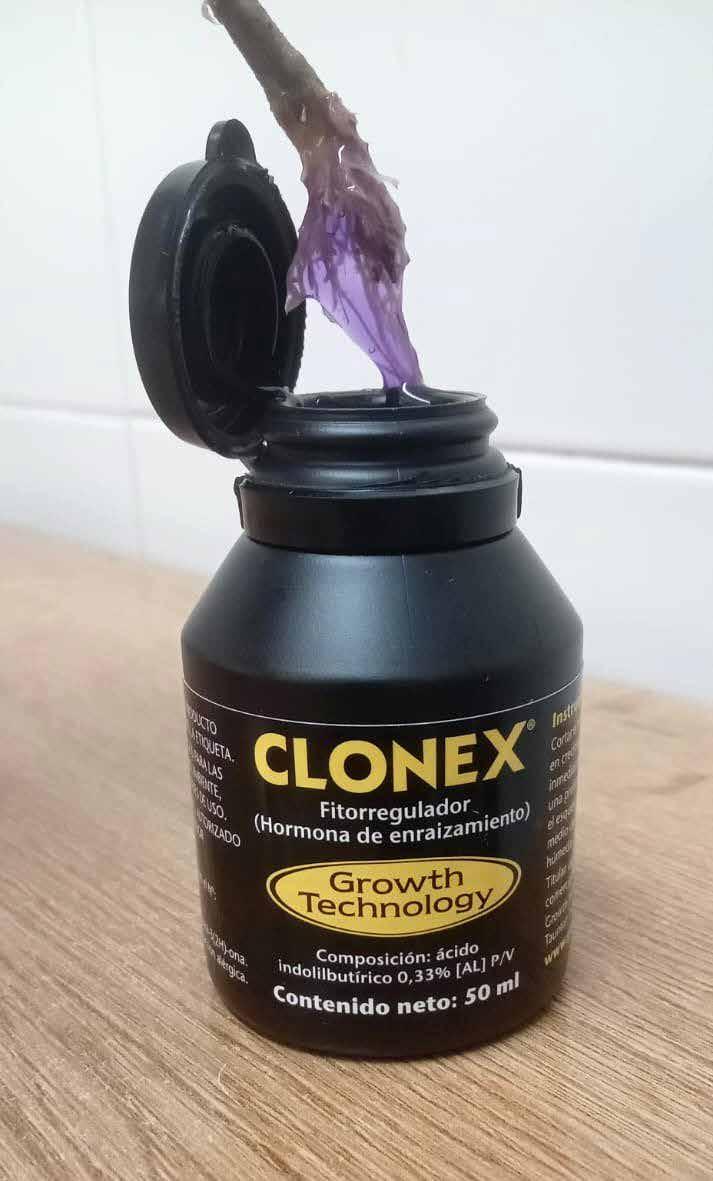
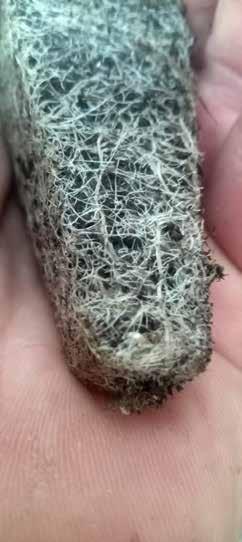
Clonex Mist : Clonex Mist is a foliar application product designed for use on mother plants and clones, promoting root development. Another advantage of this product is that it is intended to improve the health and vigor of cuttings and the root system.
Clonex Pro Start : This product is a blend of nutrients that includes organic extracts selected for their high efficacy. It is composed of seaweed, amino acids, and humic and fulvic extracts, creating a high level of nutrient absorption, strengthening the cannabis plant's metabolism and resistance to stress.
Clonex Rooting Gel: This product is the classic version of Clonex in gel form, perfect for immersing cuttings immediately after cutting. It is formulated with hormones, fungicides, and vitamins, perfect for providing the vitality that cuttings need in the first few days.
Clonex Mist Concentrate: The same formulation as the classic Clonex, but in a concentrated, easy-to-dose format, perfect for making your own solutions. This product is perfect for mass production of cuttings, making the concentrated product a perfect ally for large-scale production as it is easy to apply and easily absorbed by plants, providing the necessary nutrients for rapid recovery.
It is important to highlight the uses and benefits that Clonex Gel offers in cutting production:
– It acts as a tissue healer.
– It contains rooting hormones of over 3,000 PPM, providing the vitality necessary for optimal root development.

Another element that characterizes this product is the safety of each and every one of the materials it is made from. This is because none of the elements used to manufacture Clonex are toxic to plants, making Clonex
– It is an enormous source of nutrients and trace elements.
– The gel format ensures contact with the roots during the rooting hormone treatment of the cuttings.

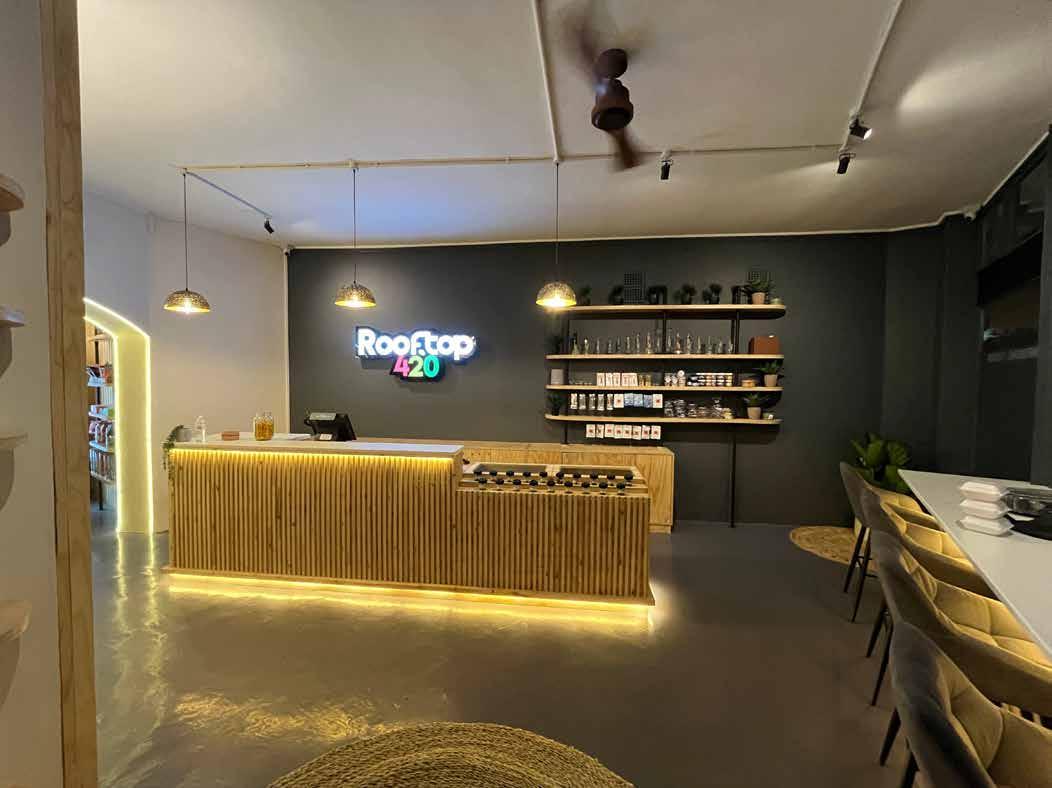


By @sudestfamily
The art of making water hashish is a technique that also includes the post-harvest phase of the resin. In fact, it's creation does not end when the resin is taken out of the freeze dryer and stored in the freezer. Water hash curing techniques allow you to transform the appearance of the resin and in some cases improve its organoleptic qualities!
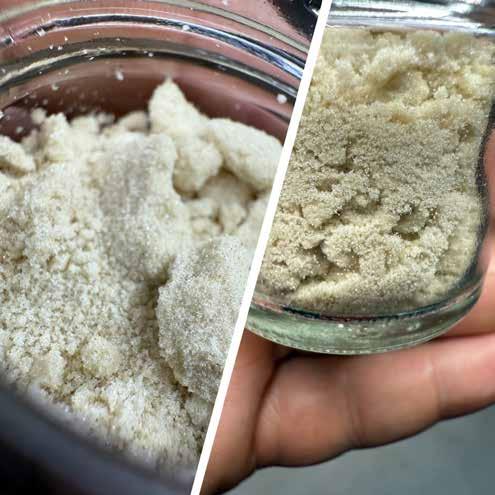
The curing process of water hash and more generally of hashish including dry sift and rosin, involves the alteration of the terpene profile and a mutation of its texture. The mutation of the appearance depends on the type of resin and the technique used. In natural conditions the resin has a crystalline structure with a very dense consistency that in jargon is called 'Glassy' or 'Sticky'. It can take on different textures, from the drier and softer ones called 'Budder' to those more similar to a marmelade jam called 'Wet'.
During the curing process the terpene profile of water hash undergoes an alteration. Some resins when cured bring out an explosive terpene profile, compared to others that instead lose the original essence.
To better understand what these transformations depend on, it is necessary to delve into some aspects of terpenes. Terpenes are volatile organic compounds and in cannabis they are synthesized inside the glandular trichomes through enzymatic reactions. Each type of glandular trichome is specialized in the
synthesis of different classes of terpenes.
The five most common monoterpenes in cannabis are myrcene, limonene, pinene, linalool and terpinolene. They are the most volatile and are found mainly in the stalked glandular trichomes. Sesquiterpenes such as caryophylene and humulene are concentrated mainly in the sessile glandular trichomes and are less volatile.
Some terpenes can be converted into other compounds through enzymatic reactions that continue to occur even during the maturation and curing phase of the resin. The alteration of the terpene profile can also be caused by oxidation and thermal rearrangement processes that give rise to new terpene derivatives.
A clear example is that of hashishene, a terpene typical of Moroccan hashish that derives from a degradation process of myrcene, as some research has highlighted. In some cases, there is simply an increase in the concentration of some terpenes that take the place of other more volatile ones, altering their profile. A very important characteristic of some terpenes present in cannabis is the ability to act as na-
tural solvents, giving them a leading role in the curing of hashish.
The Cold Cure method allows you to cure fresh frozen water hash in a controlled manner. The oxidation and maturation processes together with the role played by terpenes are responsible for the mutation of hashish. In certain conditions the glandular trichomes exude an oleoresin substance also containing terpenes that accumulates on the surface; in jargon the liquid layer on the surface is called layer. Terpenes act as a solvent capable of dissolving the resin and modifying its appearance and consistency.
The cold cure method as described by it's name is a cold hashish curing technique. The temperature range for its implementation goes from 4°C to 21°C and it is performed inside an airtight glass container, in vacuum conditions. The time needed to complete the process varies based on the temperature to which the
fresh frozen water hash, to achieve good results it is recommended to use high-quality resins, such as 6-stars.
To perform the cold cure technique you need a glass jar, a steel dabber and a vacuum machine equipped with special bags. The glass jar must have an appropriate size for the quantity of resin you want to cure; its size must be ¼ larger than the space occupied by the still powdered hashish.
For example, to cure 10 grams of fresh frozen water hash you need a 30 milliliter jar. The jar cap must have a good seal, the best are the two-piece ones typical of barrel jars. Vacuum bags with a completely transparent side are excellent for observing the evolution of the curing process.
First fill the jar with the still powdered water hash until it occupies ¾ of the available space. Close the cap tightly, place the jar inside the bag

resin is subjected. The lower the temperature, the longer the duration of the process, up to a period of two months. At a room temperature of around 18°C the time required is reduced to approximately two weeks. A slow curing process guarantees significantly better results. This method is especially suitable for curing
and seal it with the vacuum machine by completely sucking out the air. It is very important to place the jar inside the bag so that you can have a clear view of the contents once sealed.
After about 6 hours at a room temperature of 18°C the space occupied by the resin inside
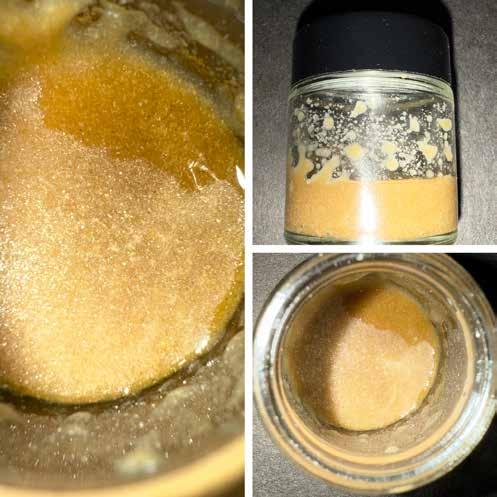
the jar will have significantly reduced, concentrating on the bottom. The resin transforms from a white or light yellow powder state to a compact, dark-colored mass.
The formation of this layer and its thickness depend first of all on the type of resin that is being cured. Each strain of marijuana has different characteristics that also vary depending on the cultivation method used. The thickness of the layer is also determined by the amount of fresh frozen water hash put to cure.
re it is absorbed again by the lower layer. This is the perfect moment to open the jar from the vacuum and move on to the third phase.
The term 'whipping' (translated from English) refers to the operation of thickening the resin performed with the aid of a dabber. It is a term borrowed from the culinary sector. Mix the resin contained inside the jar with the dabber for a few minutes, using steady movements. When the resin is well mixed, collect it in a single block, paying attention also to the parts that remained stuck to the walls of the jar. With the dabber, or wearing a latex glove, apply light pressure to flatten the mass and make it homogeneous. Whipping large quantities of fresh frozen water hash can be easily done with an electric drill and a special steel dabber. At the end of this operation the jar must be vacu-
cluded. This phase lasts about a week. After being cured, the fresh frozen water hash takes on a wet appearance called 'wet'.
Once the curing process is complete it is recommended to store the fresh frozen water hash inside a new clean jar or in special sheets such as Piattella foils. You can choose to store it in the fridge or at room temperature as long as it is not too hot. A wine fridge is the best solution. It is very important that the jar is hermetically sealed to maintain the quality of the water hash for a longer period.
Curing fresh frozen water hash allows you to express its potential to the fullest and improve
The vacuum jar should be left to rest at room temperature and in the dark (to preserve the contents from degradation caused by light). After about a week, the resin begins to sweat a liquid that accumulates on its surface, the so-called layer.
A minimum of 10 grams of powdered resin is essential to do a good job. It is important to mo-

nitor the state of the contents of the jar at least twice a day to capture the moment of maximum accumulation of the liquid on the surface, befo-
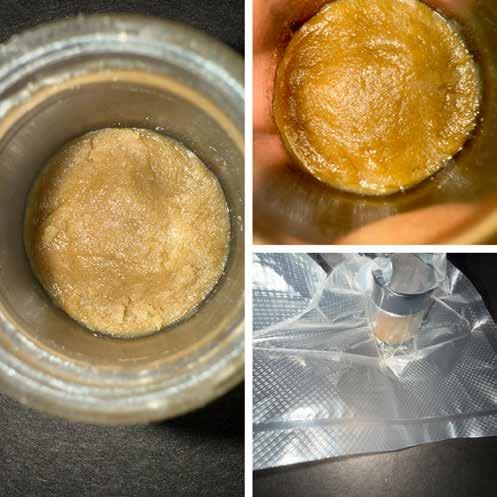
um-packed again and left to rest for a few days.
Through the jar it is possible to observe the state of mutation of the resin. Initially the
CURING FRESH FROZEN WATER HASH ALLOWS YOU TO EXPRESS ITS POTENTIAL TO THE FULLEST AND IMPROVE ITS APPEARANCE, AS WELL AS MAKING IT EASIER TO HANDLE.
resin will appear with streaks of various shades of color. As the days pass the streaks will disappear and when the color of the water hash is completely uniform the process is con-
its appearance, as well as making it easier to handle. On the other hand, the terpene profile undergoes an alteration, losing the original authentic flavor. Often, cured hashish brings out a terpene common to many strains, even when they are totally different varieties. An analysis of the terpene profile of water hash, to be performed pre and post cure, could help to better understand what type of transformation occurs.
Not all cannabis strains respond in the same way. For example, the resin extracted from the Super Boof variety has a tendency to budderize, with a drier texture that crumbles under finger pressure, unlike the Zap and CherryZ strains that appear more similar to marmelade jam and are excellent for cold curing.

Text and photography: Derrick Bergman
Many people think that cannabis is legal in the Netherlands, but that is not the case. Possession and sale are tolerated within strict rules, but cultivation and supply to coffee shops is still illegal. An official experiment in ten municipalities is now testing regulation of the entire chain. One of the ten licensed growers, Hollandse Hoogtes, opened its doors to Soft Secrets!
Our tour guide is the man they call Karma, founder of the seed bank Karma Genetics. He is also the head of genetics at HH. We started in the room with mother plants, followed by a room with cuttings, and then three rooms with plants in different stages of flowering.
Everything was impeccably clean, and the plants could be moved from one room to another using a handy rolling system. The last room we visited was full of plants that were about to be harvested; the smell was overwhelming. In the trimming area, dozens of employees were trimming. Weighing and packaging were also done by hand. HH also uses trimming machines, but we didn’t see them in operation during the tour.
At the time of our visit, there were fifteen grow rooms, with plans to expand to over twenty in the second phase. HH grows with rockwool and coco substrate. Karma explains: “In the beginning, the mold limit was very low, and growing organically in soil is a risk in that case. With rockwool and coco, you can grow much cleaner to meet the requirements of the NVWA.” (The NVWA is the Dutch government agency that inspects licensed growers. – ed.) The part of the facility housing the massive vats of nutrients resembled a factory. About the nutrients, Karma said: “We grow synganically, with our own recipes. The products come from various brands.”
Harvested plants are dried for an average of 14 to 18 days and then cured for at least four weeks. In addition to weed, Hollandse Hoogtes also produces prerolls, whole plant fresh frozen hash and rosin in various forms.
Location: Bemmel, province of Gelderland Website: www.hollandsehoogtes.nl
Number of employees: 144
Number of square meters of flowering plants: 3500 m2
Total number of plants: approx. 30,000
Number of species: 45
Number of kilos per week: 200
Number of joints per week: 80,000
Substrate: Rock wool and coco
Grown strains: Gelato 41, Exodus Cheese, Super Silver Haze, Gorilla Glue, Zowah, ZiZi
*: figures at the time of visit, April 2025




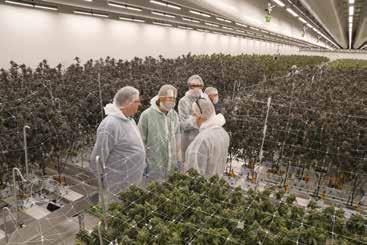


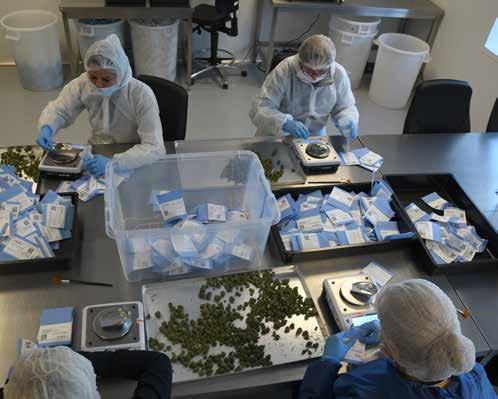
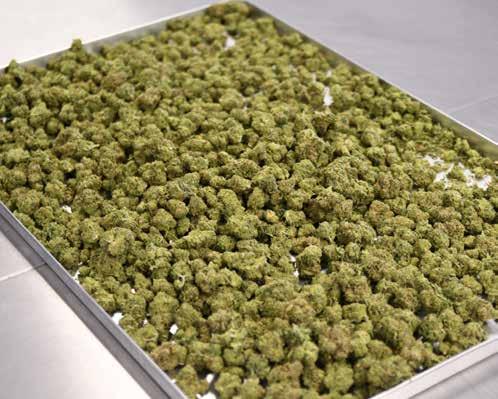



Stoney Tark
Photoperiod plants refer to cannabis plants that are dependent on a light cycle to grow. Indoors, for example, photoperiods will stay in a vegetative state when the light cycle is 18/6, then flower once they receive 12 hours of dark and 12 hours of light.
Photoperiod plants vegetate outdoors from May until late July before transitioning to flowering. At this time, they stretch and double or triple in size, start to show pre-flowers, and later develop buds.
Photoperiod can grow into large plants outdoors over the summer, allowing you to harvest huge yields. Compared to autos,
photoperiod requires much more time, effort, and maintenance.
A grower can train a photoperiod plant for months, meaning the shape and structure can be manipulated to the desired shape. Autos cannot be trained for more than 4 weeks, as flowering is automatically induced regardless of the number of lighting hours.
Photoperiod plants can be cloned during the vegetative stage, meaning you can produce an actual plant that is a genetic clone of the plant from which it was taken.
Clones can be turned into mother plants, which allows you to source more clones in the future. A mother plant can be grown indoors under an
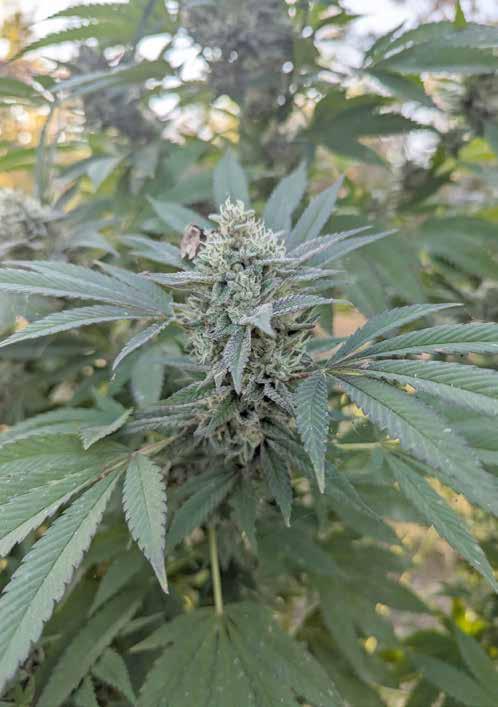
18/6 light cycle, and as long as it is not allowed to flower, mother plants can be kept alive for years with no issues.
There is a wide range of photoperiod cannabis plants available to buy online, and they will be either regular or feminised. Most seed banks sell feminised photoperiods, eliminating the need to sex plants and remove potential males.
Autos are small to medium-sized plants that contain a gene called Ruderalis. This means that they will be identical to photoperiod plants. However, they have a short life cycle from seed to harvest, typically around 10-12 weeks. Auto-flowering cannabis plants can be grown indoors under 18/6 or 20/4, producing excellent results.
Suppose you want a medium-sized plant that keeps your plants low profile, requires little maintenance, and is exceptionally resilient to cold climates. In that case, autos are your best candidates. Compared to a large-sized photoperiod, growers who experience short summers will find autos the best genetics to work with.
Thanks to their short to medium height, autos can be planted in many outdoor spaces, from a balcony, terrace, greenhouse, or back garden to a large windowsill that receives sunlight. Autos are incredibly diverse and can be grown in a sunny backyard in multiple locations.
Autos do not require much maintenance and are very easy to grow. They are ideally suited for a first-time grower or a person who cannot tend to their cannabis plants daily due to a busy work schedule.
Auto-flowering plants are optimal for hiding your outdoor crop from neighbours and the authorities. I have grown many autos in a sea of green formations in my back garden without them reaching more than 100 cm tall.
With such a fast turnaround from seed to harvest, a grower can plant autos every 11-12 weeks, meaning you can harvest autos back-toback under the right circumstances. Suppose you know your photoperiod plants have never had a chance to mature fully due to limited weather. In that case, you cannot go wrong with autos planted from May until early August.
Auto-flowering cannabis plants may not allow a grower to train them continuously, unlike photoperiods. However, tying them down and using big pots will yield much better results. Avoid
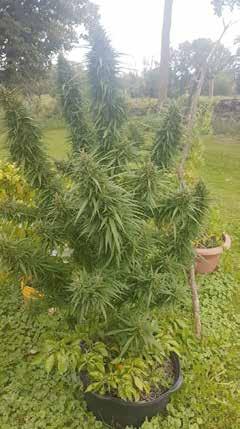
topping autos, especially as you get close to day 28 from germination, as they won’t have enough time to recover, resulting in small-sized plants.
Tip #1: Growing auto-flowering and photoperiod cannabis plants side-by-side is a great way to plan for multiple harvests over the summer. You can harvest your autos in July and August, then prepare for another big harvest by mid to late September.
Tip #2: Growers in Northern Europe who cannot guarantee consistent sunny weather will find that autos are the most resilient cannabis plants for them. Nothing is worse than a photoperiod plant that did not get the chance to produce big, fat buds due to the climate, so research which fast-flowering Indica autos are available to buy.
Tip #3: If you do decide to work with photoperiod cannabis plants, then using feminised seeds will ensure that every plant produces females and only buds. Regular seeds can produce male plants and require removal, limiting your final plant count and potential yields.
Photoperiods require more effort than autos. However, the yields are dramatically better. Growing autos in a Sea of Green is one way to produce an epic harvest with a fast turnaround time.
Tommy G./ Photos: Jaypp and Sweet Seeds®
Celebrating the 20th year in the market, Sweet Seeds® surprises us again with a quite interesting group of new strains. Today, we are going to talk about a next-generation polyhybrid that promises to make waves among extraction enthusiasts and high-potency cannabis lovers. Say hello to Monster Maker® (SWS117), a strain released in early 2025 that combines high resin production, delicious terpenes, and a well-balanced effect that’s as creative as it is relaxing.
The name doesn’t lie, because this strain is a real beast in every sense. Monster Maker® is a photoperiod-dependent strain, making it an ideal plant for growers who enjoy training and shaping their plants or want to keep mother plants for cloning. On top of that, it’s a resin machine, perfect for creating concentrates with an excellent yield and mouth-watering flavor.
Grown Indoors with Style I recently had the chance to test Monster Maker® indoors under LED lighting, using coco substrate and a solid mineral feeding plan, enriched with microbial life and enzymes to

boost root vitality. As expected from a strain with Chimera #3 and Permanent Marker in its genetic mix, the plants developed quickly and with outstanding vigor.
The structure of this cultivar is compact yet well-branched, with short internodal spacing that helps maximize yield in tight grow rooms.
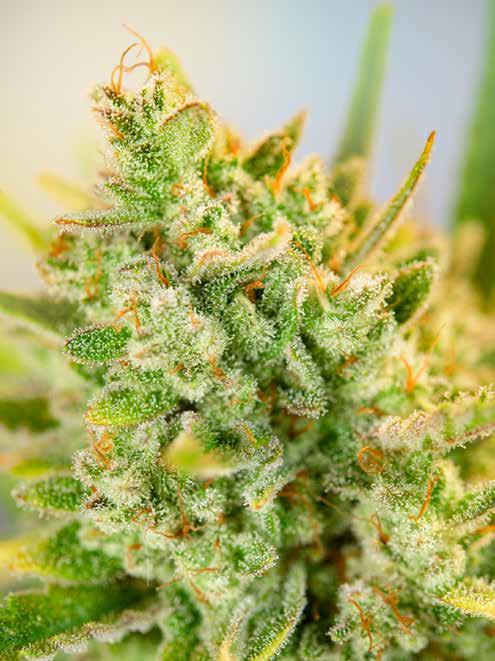
The buds are heavy, dense, and coated with sticky resin that builds up early in flowering and just keeps getting thicker. With this strain, there are no issues with nutrient sensitivity, and it responds well to both LST and topping.
Besides that, this strain doesn’t stretch too much in the transition from vegetative to flowering, making it ideal for growers working in limited vertical space. By week eight of 12/12, the plants were already sending signals that they were ready to wrap things up, and by the ninth week, they had reached full maturity with swollen buds that looked dipped in sugar.
With THC levels that can reach up to 30%, it’s crucial to monitor trichomes closely toward the end, because you don’t want to miss the ideal harvest window, especially if you're aiming for a more balanced effect rather than a full-on couch lock. This is even more important if you are going to use the harvest or part of the harvest for extractions, as you will want to have the terpenes as fresh and intact as possible.
And now, the best part: the tasting. Monster Maker® doesn’t just deliver potency: it delivers an aromatic journey that starts with fresh cypress and citrus notes and evolves into a deeper blend of Diesel and earthy undertones. This complexity comes directly from its elite genetic background: Chimera #3 brings the gassy and earthy elements, while Permanent Marker contributes a cocktail of fresh and sweet citrus, with some of that famous Biscotti-style creaminess in the background.
On the palate, it’s an absolute treat, featuring strawberry and lemon on the front end, followed by mandarin and berries that make every puff a full-spectrum flavor experience. Vaporizing this strain brings out the bright citrus top notes, while a joint gives a richer and earthier finish.
The effect is exactly what you would want from

a modern hybrid: it starts with a boost of creativity and mental energy, perfect for brainstorming, drawing, or just vibing with music After a while, a warm wave of relaxation washes over, grounding the experience without taking away your ability to think clearly. It’s ideal for late afternoons and evenings when you want to wind down without falling asleep.
One of the standout features of Monster Maker® is its exceptional resin production, which makes it a top-tier candidate for all types of extractions, from dry sift and bubble hash to solventless rosin. The buds are absolutely drenched in trichomes by the end of flowering, with a thick, sticky layer that extends even to the sugar leaves, making even the trim-worthy material nearly as potent as the flower itself.
Whether you're pressing live rosin or whipping up some terp-rich BHO, the returns are impressive both in quantity and quality. The terpene profile shines through in concentrate form, especially the sweet citrus, wild berry, and Diesel notes, which translate beautifully into flavorful dabs. Thanks to its high THC content, extracts made from Monster Maker® don’t just taste great; they hit with intensity and clarity. If you're into crafting artisanal concentrates with maximum terp and cannabinoid expression, this strain is more than up to the task.
Monster Maker® lives up to its name in every category: flavor, resin production, potency, and ease of growth. Whether you're a home grower looking for something new or a collector on the hunt for the next big thing, Monster Maker® is a high-caliber photoperiod-dependent strain that won't disappoint.


The legalization of cannabis in Thailand was an event of epic importance with a strong economic and social impact on a large portion of the local population. While on the one hand, legalization has legitimized the use that Thais have historically made of cannabis, on the other hand, it has generated a huge job market, attracting the interest of foreign investors and operators in the sector.
Cannabis is generating great hopes especially in rural areas where unemployment is high. Although local salaries continue to be very low, in line with those of a common worker who in the best of cases earns around 400 euros a month, the cannabis industry is creating thousands of new jobs. Furthermore, there are many people who were forced to move in the shadows risking their lives, who today freely work with cannabis. Legalization is giving a strong boost to the Thai economy also indirectly, such as in the tourism sector with the birth of a category of visitors interested above all in marijuana and its easy access.
Currently the regulatory framework for cannabis is quite confusing. In fact after the Thai government removed cannabis from the list of narcotic substances in 2022, there has been no real regulation, leaving a legislative vacuum that has contributed to the wildfire expansion of the cannabis sector. The new government has proposed a bill that aims to regulate the sector, with the clear intention of limiting recreational use but it is still only a proposal under discussion. To date, if you want to grow and sell marijuana in Thailand the process to follow is to obtain all the necessary licenses. It's quite simple.
As for Thai citizens, they must first register on Plookganja, an app created by the FDA, where growers declare some information such as the place where the cultivation is carried out, the number of plants grown and the final purpose of the cannabis cultivation. Once registered, you obtain the license to grow, the cost is around 85 euros. Subsequently, you need to contact the Ministry of Health, more precisely the Department of Traditional and Alternative Medicine of Thailand, to obtain a license to sell marijuana.
Thai citizens who want to grow cannabis for therapeutic purposes only need a medical prescription from a licensed doctor. For growing hemp, no license is required as long as the THC content is less than 0.2%.
Foreigners who want to operate in the sector, according to the Foreign Business Act, are required to form a company with a Thai
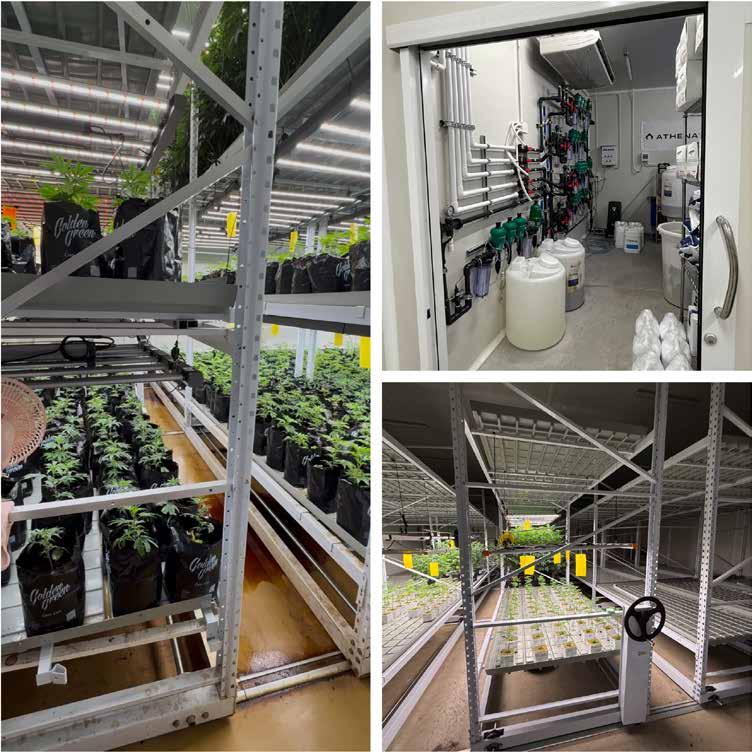
citizen who holds 51% of the shares, called a Thai Limited Company. The procedure for obtaining licenses for cultivation and sales is the same as the one described above. The licenses last three years after which they must be renewed and for each new cultivation or point of sale it is necessary to request a specific one for each location.
There are other types of licenses that are issued by the Ministry of Health or by the Thai Food and Drug Administration. Their value come from conflicting sources and concern import, export and manipulation. The import
license is limited only to cannabis seeds, excluding plants and their parts intended for research and the pharmaceutical industry. To introduce seeds and plant parts into Thai territory a quarantine period is mandatory, regulated by the Ministry of Agriculture. To obtain an export license, you need to have an international partner that is compliant with the laws of the place where it operates, and marijuana companies must meet GMP and GACP requirements as a standard. The license for the manipulation of the marijuana plant covers all edible products, cosmetics and extractions such as dry sift and water hash.
The Thai climate is very favorable for growing marijuana outdoors or in special greenhouses, in fact the average annual temperatures vary between 24°C and 35°C. A very interesting feature is the duration of the hours of light and darkness, equal to about 12 hours throughout the year with small variations; the photoperiod of 12/12 is perfect for the flowering of cannabis allowing growers to obtain up to 3 harvests in a year. In these cases, growers grow their plants indoors or in a greenhouse with the support of lights to keep the plants in the vegetative

phase, when they reach the desired size they are exposed to direct sunlight thus passing into the flowering phase. The duration of this phase varies based on the strains grown. Thai landraces have much longer times allowing a maximum of two harvests each year unlike hybrid and stabilized varieties which often turn out to be much earlier.
Most outdoor grows are located in the northern regions of Thailand where temperatures are slightly cooler compared to the scorching heat of the central-southern provinces.
One of the main problems for growing marijuana is humidity, with a rate of about 70% throughout the year it is a real headache for all growers who live in Thailand.
Greenhouse cultivation is a valid alternative that is becoming increasingly widespread, allowing greater control over the climate. Many of these greenhouses are equipped with air conditioning, fans, dehumidifiers and support lighting, they also ensure greater protection against pests and above all offer coverage from the rain. In fact, Thailand is affected by rain for most of the year and during the summer season it is hit by violent monsoons.
Growing marijuana indoors is the option adopted by many growers, especially foreign ones who have more capital to invest and a different set of knowledge. Indoor cultivations range from small improvised grow rooms to large industrial warehouses complete with all the technology available on the market and nothing to envy to the grow rooms of North America. Sealed Rooms are very common in indoor grows, a type of grow room that allows for complete climate control and is considered the best option for keeping Thailand's heat and humidity at bay.
During our stay we had the opportunity to visit a large legal cultivation inside a warehouse.
pleasantries and a marijuana joint to settle in, we began the tour inside the facilities. The first room was used as a refreshment area, followed by a conference room and a changing room for the workers. The head of operations, a very nice Asian guy, provided us with a lab coat and sanitary slippers to wear so as not to contaminate the cultivation environment.
fertigation, from which the pipes branched off to the grow rooms.
The facility was located in one of the industrial areas of Bangkok, an area that is full of huge marijuana cultivation operations. The
IF YOU WANT TO GROW AND SELL MARIJUANA IN THAILAND THE PROCESS TO FOLLOW IS TO OBTAIN ALL THE NECESSARY LICENSES. IT'S QUITE SIMPLE.
warehouse had a parking lot inside its fence, at the entrance we were greeted by our contact on site and his team. After the usual
From the changing room we accessed the area intended for production through a door equipped with a facial recognition system for its opening. This area of the structure was built entirely with insulated walls and hermetic doors typical of laboratories. Through a long corridor you could reach the cultivation and post-harvest rooms. The shed in fact housed three rooms for the flowering of the plants, one for the vegetative phase and the mother plants, a room for irrigation management, a dry room, a room for manicure operations and finally a warehouse where the ready marijuana flowers were stored in special sealed plastic bags and at a temperature of about 12 ° C to preserve their quality. It goes without saying that there were entire shelves full of bags of marijuana ready for sale. Two of the rooms used for flowering measured more than 100 square meters and were lit by 60 x 750w LEDs, while in the third room racks for vertical cultivation had been installed, lit by 40 x LED lamps distributed on two levels. The rack solution had also been adopted for the room used for vegetative growth. All the grow rooms were sealed rooms, equipped with air conditioning, large dehumidifiers, fans, odor control filters and a CO2 supplement system.
The highlight was a device for the treatment and sanitization of the air, called UTA, essential to comply with GMP and GACP standards. The irrigation of the rooms was performed through an automatic drop-by-drop system; the room used for irrigation management was equipped with various Dosatrons, a dosing system for
The plants initially grew in rock wool cubes and when they were transferred to the flowering rooms they were placed on slabs of the same material to give the roots more space to grow. Inside the laboratory where the flower manicure was performed, 12 people worked exclusively on the trimming phase full time.

Each of them was equipped with a trimming station, that is, an ergonomic support tray with a screen on the bottom to collect the resin, specific for these operations. The installation was able to produce approximately 130 kg of marijuana each cycle, for a total of 650 kg each year. This marijuana factory employed about twenty people, all of Thai nationality except for the manager and the head of cultivation operations, our Spanish contact.
Currently the market in Thailand is very wild and above all saturated with marijuana.
The Ministry of Health has issued so far over 12,000 licenses that authorize its sale. Bangkok is certainly the place that offers more opportunities than the rest of the nation, but even the islands, despite the lower prices, are a good compromise.
All in all, modern-day Thailand is an exiting new chapter in the thousand year old story of cannabis!
Unlike the average standard of living in Thailand, the price of marijuana is really crazy. In the center of Bangkok the average price of 1 gram of cannabis flowers grown indoors is around €30, slightly lower for that grown in a greenhouse which is around €20 per gram, up to €10 for outdoor marijuana.
These prices are also found in other locations such as Pattaya and the islands of Phuket and Koh Samui. It is quite clear that they are only accessible to tourists. The story changes in the suburbs and rural areas, especially in the north of the country, in fact 1 gram of excellent quality indoor marijuana costs around €12 but it is also possible to find much cheaper flowers that range from €4 per gram.
The average price for 1 kilo of marijuana grown in a greenhouse is €600 while top quality indoor marijuana reaches €1500 per kilo.
As for hashish, in Thailand there is no real culture like in other places, traditionally here they only smoke marijuana. The most common type of hashish is Dry Sift, obtained by manicuring the flowers performed on a special sieve or by processing the remains with the pollinator. The most honest dispensaries sell it for around €20 per gram.
Fresh Frozen Water Hash is still not very widespread and is produced exclusively by European growers and hashmakers. The price starts from €35 per gram up to over €60 for the best qualities. In wholesale its price drops significantly to €12-15,000 per kilo. Seeds and cuttings are also quite expensive, the price of clones varies based on the quantity, starting from €5 up to €15 when it comes to a few units and they are the most common propagation method.
On the Thai market there are several world-famous Seeds Banks active, a package containing three seeds of commercial varieties can cost up to €40. So basically the prices are the same as in Europe.
The Thai cannabis scene is not for the poor!

Growing Mr. José, info@pestovat.cz
Every home grower needs high-quality starting material to achieve a good harvest. Most people buy seeds or clones from a store when they have the option. However, you can also produce clones yourself and keep growing the varieties that suit you best—over and over again. And you don’t need much extra space to do it. I’ll show you how.
One of the main advantages of growing from clones is that you can already tell whether the plant is vigorous and healthy when selecting it. You also avoid problems related to seed germination, where many people make mistakes that reduce germination rates. Producing your own clones isn’t completely straightforward either, but once you learn how to do it, you can make enough clones for each grow cycle and pick only the best ones.
A good mother plant is the cornerstone of a successful grow. Professional cultivators and clone producers cherish their top-quality mother plants, as they are literally irreplaceable. Clones taken from the same mother share identical growth characteristics and typically produce buds with the same levels and ratios of active compounds. From a single mother plant, you can create countless more mothers—enough to supply clones even for large-scale commercial production. But for home growing, one healthy mother plant is usually all you need.
You can create a mother plant from a single feminized seed, from purchased clones, or from a cutting gifted by a friend. The key is to keep the plant in the vegetative stage and occasionally pinch off the top to encourage the development of side branches. A mother plant doesn’t need to grow tall, but it should produce enough young shoots with sturdy stems. If you create a mother without prior selection, you won’t know how good the plant’s yield or effect is until after the first harvest—but you might get lucky. Proper selection requires more space, which not every grower has.
If you want to select a truly high-quality mother, it’s best to start with at least ten regular (non-feminized) seeds. From the moment they germinate and start rooting, observe the plants and focus on the strongest individuals. After two to four weeks, you can discard weak or deformed plants. Again, topping the plants will encourage more side branches, as shown in the accompanying image. After about five weeks, the plants should be big enough to take the first few clones. Be sure to label the clones carefully so you’ll know which temporary mother plant each one came from.
The clones are used for a trial grow cycle. Usually, taking two clones from each poten -

tial mother is enough, but the more you test, the better your assessment will be. The test run also helps identify and eliminate male plants, so pay close attention to the earliest signs of male flowers and discard both the clone and its original mother plant. By around the third week of flowering, only female plants should remain in the trial, which you’ll grow to maturity. At the end of the cycle, evaluate the results and select one or two temporary mothers whose clones performed best. Take new clones from them, and select the strongest ones—these will become your final mother plants for future use.
A simpler and more common approach is to
select from feminized seeds, which removes the need to identify and discard male plants. With many modern strains, it’s difficult to even find regular (non-feminized) seeds, so feminized seeds are often your only option. Keep in mind that autoflowering strains cannot be cloned, since they begin flowering too early—before clones can properly root. Selection and testing will take about six to twelve months, but the result is well worth it: a starting genetic base tailored exactly to your needs.
Cannabis is very well suited for asexual propagation, which is just another term for
cloning. Sometimes, all you need to do is cut a sturdy shoot and place it in water— roots may appear within a few weeks. But you’ll get better results by creating optimal conditions for rooting. I recommend using a small seedling greenhouse (propagator), ideally one with a heated base, which helps speed up the rooting process. That said, you can also succeed without heating. The ideal root zone temperature is between 22–26 °C (72–79 °F), which is easy to maintain indoors, even without a heated propagator.
Spread 2–3 cm (about 1 inch) of perlite on the bottom of the propagator. It absorbs excess water from the rooting cubes and creates
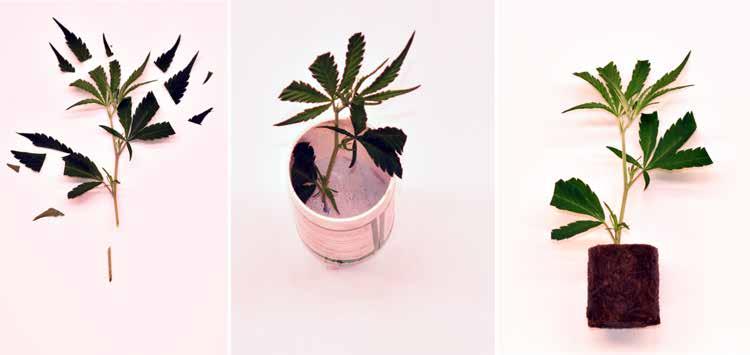

a perfect environment for roots to grow through. You can find rooting trays and cubes in any grow shop. There’s a wide range of growing media available—from soil to coco
SELECTION AND TESTING WILL TAKE ABOUT SIX TO TWELVE MONTHS, BUT THE RESULT IS WELL WORTH IT.
coir to the widely used rockwool. I personally prefer rockwool for cloning: it’s easy to handle, retains water well, and typically doesn’t harbor pests or diseases.
To root successfully, clones need the right light spectrum and a sufficiently long day. I recommend giving them 24 hours of conti -
nuous light. You can use suitable LEDs or older T5–T8 fluorescent tubes. A light intensity of around 100 µmol/m²/s is enough. In other words, for a propagator measuring 60×40 cm (24×16 inches), you’ll need an LED with a power draw of around 10–20 watts.
If you plan to root clones on a windowsill or in a greenhouse, be sure to add supplemental lighting to ensure at least 18 hours of light per day. For consistent rooting and even growth, I strongly suggest sticking with a 24hour light cycle during this phase.
You’ll also need a sharp knife and a rooting hormone, which is available in most grow shops or garden centers. Before you start cloning, soak the rooting cubes in water with an adjusted pH of around 6.5 (anything between 6 and 7 is acceptable). If using rockwool or coco, I recommend adding a rooting stimulator to the solution. Let the cubes drain, then place them in the propagator on top of the perlite. Pour a small amount of rooting gel or powder into a separate container for dipping the cuttings.
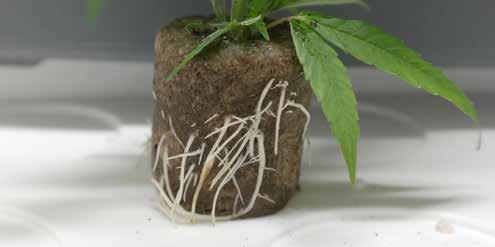
Select a suitable shoot for cutting. The best cuttings are young shoots about 10–15 cm (4–6 inches) long with a firm stem. Stems that are too soft don’t insert well into the medium, while thick, hollow stems are difficult to root. Many growers wonder whether to cut the stem straight or at an angle. I’ve never noticed a significant difference in rooting speed either way, and experimental trials have come to the same conclusion—so it’s purely a matter of preference. Personally, I prefer angled cuts because they’re easier to insert into the medium.
After cutting the clone, remove about half to two-thirds of the leaf surface. At this stage, the plant doesn’t need that much leaf area, and reducing it also lowers the risk of mold. You can remove the lowest leaves entirely. Dip the cutting in rooting hormone and insert it into the pre-soaked medium. Once all your clones are ready, place the lid on the propagator and set it under the light. Check the temperature regularly, and around day five, see whether the cubes need watering. Roots usually appear within 10–20 days.
Once rooted, transplant the clones into larger containers as soon as possible. The longer rooted clones stay in their trays, the more their quality declines.
So, will you give cloning a try? If so, I wish you the best of luck—and don’t give up if it doesn’t work perfectly the first time.




Text: Olivier F./Soft Secrets France
“I didn't want to live like a criminal all my life.”
Steve DeAngelo is an American cannabis activist for more than 40 years, businessman and TV host. He is very famous in the USA, where he was nicknamed “The father of cannabis industry“. Steve was an illegal marijuana dealer who became legal entrepreneur in later life. Soft Secrets interviewed him.
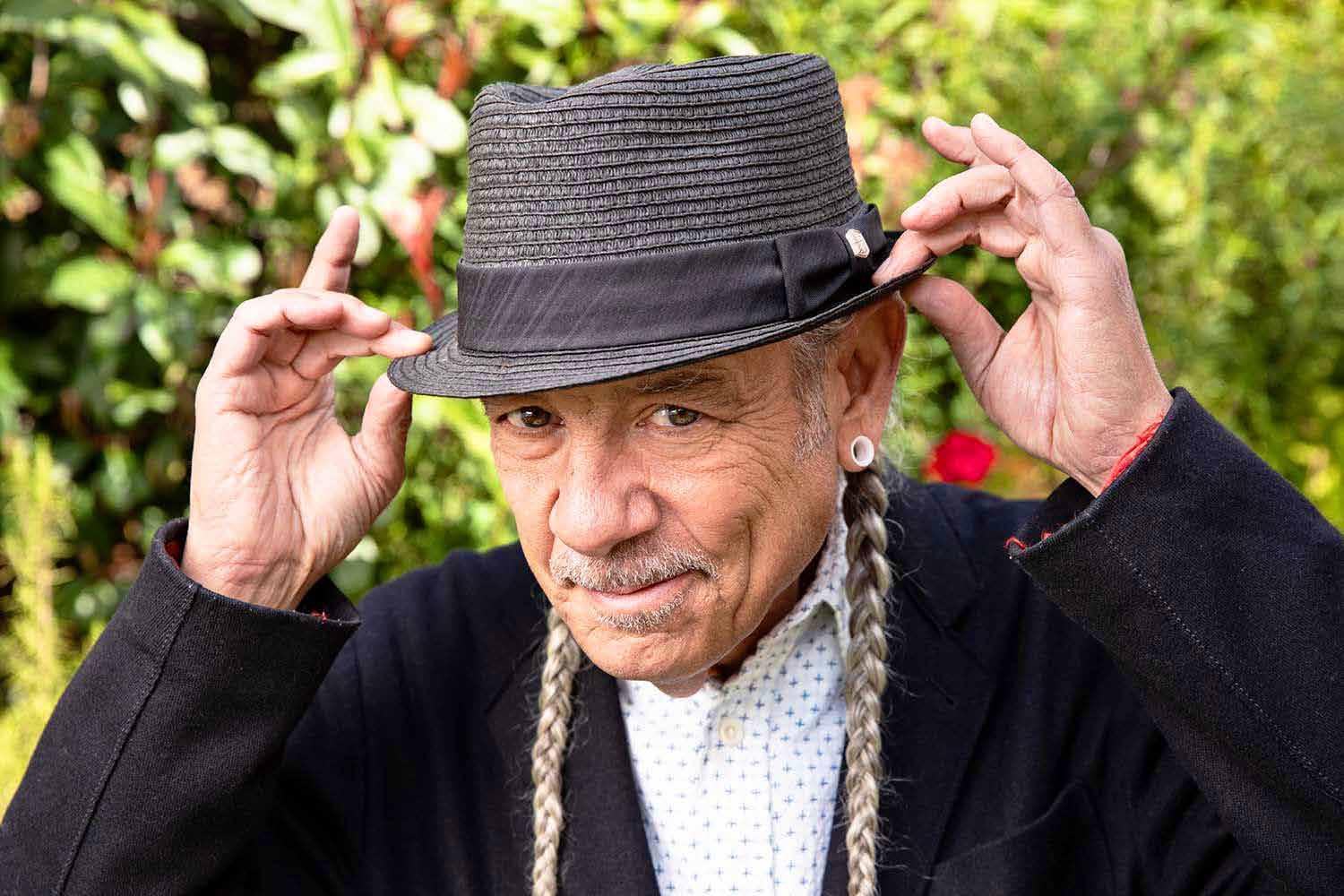
SSFR: Steve, when did you first discover cannabis? And when did you start advocating for it?
Steve DeAngelo: I first discovered cannabis when I was 13, and my first experience was truly transformative. I fell in love with the plant the first time I tried it. I felt called to it. I grew up in Washington, DC, the capital of the United States. It was at a time when there were a lot of protests for various reasons:
civil rights, racial equality, protests to end the Vietnam War, and anti-nuclear power. My parents were involved in the racial justice movement and the civil rights movement. So I grew up in a household where activism was prevalent. I was taught that if I saw an injustice or someone suffering and I had the ability to do something about it, I would.
When I first had my experience with the plant, I thought, "This isn't a bad plant, this is
a good plant," and the idea of it being illegal just outraged me. I also understood from the beginning that this plant was going to be with me for the rest of my life. I knew that intuitively. I didn't want to live like a criminal for the rest of my life. I didn't want to be hounded by the government for the rest of my life. So, for all those reasons, it came naturally to me to start thinking about cannabis activism. So I started educating myself and looking around to see if there were any cannabis activist
organizations. There weren't any at the time. Where was your first cannabis protest?
I was 13 when I fell in love with the plant. I was thinking about cannabis activism, but it wasn't until I was 16 that I saw my first opportunity. There was this group called the Yippies, and they held what's called a "smoke-in" on July 4th, Independence Day, in downtown
Washington at the Washington Monument, which is very close to the White House. And it seemed like an exciting thing to do.
So that was my first cannabis protest. We went over and found a guy I didn't know, Dana Beale, who had about a two-pound bag of weed that hadn't been rolled into joints and that he'd just shown off on the grounds of the Washington Monument... I rushed over and started helping him by taking the weed and rolling joints, then lighting the joints and passing them out to the crowd.
I later found out that Dana was a very committed cannabis activist, truly one of the most committed cannabis activists I'd ever met. But he wasn't the best organizer. And so, no stage had been prepared. No speakers
I STARTED SELLING BECAUSE I COULDN'T AFFORD TO SMOKE OR PAY FOR THE AMOUNT OF CANNABIS I WANTED
had been scheduled. The weed hadn't been rolled into joints in advance, but there he was, keeping the faith and getting people to smoke. So, over the years, I worked with this group, the Yippies, and I developed the smoke-in over several years into a very large three-day event. At one point, there were stages with 25 different groups and 30 or 40 different speakers. So, that was the beginning of a period of activism for me.
Why did you start selling marijuana?
I started selling because I couldn't afford to smoke or pay for the amount of cannabis I wanted. So, very soon after I started smoking weed, I started to understand the cannabis business. And I think during my first smoke, I asked myself, "Where do you get this stuff? How much does it cost?" And so, I had already worked hard to become a pretty big weed dealer over those few years.
You wrote a book called The Cannabis Manifesto…
This book is now published in three languages: English, Spanish and Portuguese. And it's received truly incredible reviews. I've started work on a second book tentatively titled "How Not to Legalize Cannabis."
I think The Cannabis Manifesto is a great read for anyone new to cannabis. It really delves into the history and some of the cultural aspects of cannabis. I talk about the history of prohibition and even give an international perspective on it. Most importantly, I think I've really introduced a new way of looking at cannabis in this book that doesn't just reflect the prohibitionist idea of cannabis as something that gets you high. I really wanted
to examine the effects of cannabis as a wellness product, because I believe that's what it is. And wellness is very broad. It can be important for some of the serious illnesses we know about.
But cannabis also has another range of effects that are often thought of as just highs. But I think they're actually feel-good
In the United States, you're one of the most well-known cannabis advocates. What documentaries or television shows have you been involved in?
The most notable video production I've been involved in is the very first reality TV show about a cannabis dispensary, known as Weed

effects that can help with creativity. That's how cannabis can help people. It can help a musician find the right note, help a poet find the right word… It can help a painter find the right color. Cannabis can bring you closer to nature. It can turn a walk in the woods or a stroll in the park into an almost spiritual experience. Cannabis can encourage us to take inventory of ourselves, examine our own actions, and make sure that our daily actions are truly in alignment.
Wars, on the Discovery Channel in 2011. It's now available on YouTube. And I've been involved in many documentaries and interviews. I don't really remember the list of documentaries, interviews, television shows... I was very well known for my interview with Bill O'Reilly, one of the great conservative talk show hosts. So, I've been on Fox TV. I've been on CBS and NBC. The other notable project I've been involved in is Radio Free Cannabis, which you can still find on my YouTube channel. Radio Free
Cannabis was a global cannabis news show that we aired for about 26 episodes.
Can you tell us about The Last Prisoner project?
In 2018, my lifelong goal of legalizing cannabis was achieved in the state of California, but there was a problem with the legislation. California legalized cannabis, but didn't release any of the cannabis prisoners. And if you look across the country, none of the other states that have legalized cannabis have released their prisoners. Can you imagine how someone in that situation feels, looking out and seeing this new legal cannabis industry being built? As a movement, we can't allow the people who brought this plant through the darkness of prohibition, who made it possible for everyone to use cannabis during those years, to remain in prison. At
CANNABIS CAN HELP A MUSICIAN FIND THE RIGHT NOTE, HELP A POET FIND THE RIGHT WORD… IT CAN HELP A PAINTER FIND THE RIGHT COLOR
that time, I was a celebrity in some ways. The fight with the federal government really put me on the front pages of newspapers, and I was seen a lot on television shows. Some businesses were doing quite well. So I used the status I had developed to go to these companies and ask them to support the Last Prisoner Project. The Last Prisoner Project was then launched.
You work with the seed bank Blimburn Seeds as global ambassador. What exactly is your role?
I explain Blimburn Seeds' mission, which, today in the United States, is to provide a selection of genetics tailored to the needs of home growers. Blimburn is really focused on meeting the needs of these small growers. I explain what they're trying to accomplish here in the American market. Of course, in Europe, there are armies of home growers. In the United States, there are fewer. Because, you know, people who grow even very small amounts of cannabis have been sent to prison, sometimes for 5, 10, 15 years, for producing, growing, their own personal quantities of cannabis. So there have been fewer home growers in the United States. I do what ambassadors do: I attend events. I speak to the media. I know what's happening here on the streets, in the cannabis community. I talk to growers and self-producers. I talk to breeders. I get an idea of what's going on. And then I report back to Blimburn.
Thank you very much Steve for talking to Soft Secrets, and we wish you health and succes for the future!

Text and photography: Derrick Bergman
His name is forever attached to Mellow Yellow, Amsterdam's first real coffee shop, which he started with a few close friends in 1972. But Wernard Bruining also helped start the cannabis revolution, opened Europe's first grow shop and pioneered medicinal CBD oil. As if that were not enough for a lifetime, Wernard founded Soft Secrets in the 1980s, as the in-house magazine of his grow shop. For Soft Secrets' 40th anniversary, we made a portrait of this living legend in the European cannabis scene, a true hippie with a dislike for hard work and commerce.

Wernard Ernest Bruining is born on 14 August 1950 in Sorong, New Guinea, which was then a Dutch colony. He spent his first ten years of life there, then the family moved to the Netherlands.
‘In total, I did go to 20 schools,’ he says later*, ‘so I am very detached. I don't belong anywhere.' Wernard wants to become a teacher and in 1968 reports to the teacher training college in Amsterdam. In his second year of study, he is introduced to cannabis. It makes him realise that school is not training him to teach children to think independently, but to teach them to obey.
He quits his studies, has a few jobs and then starts running a youth centre, called Second Home, with a few friends. There is plenty of weed and hash smoking going
on there. 'With weed smokers, you always have one or two who know where to get it from. They make the buy and then distribute it to their friends. It was like that in our youth centre too. Every so often, someone would go and buy something and then distribute it. If you did that well, you kept some and it was free. That was the sport.' The floor he shares with friends at Second Home will become a gathering place for cannabis lovers.
In 1972, the idea of turning this life style into a job arises. Wernard and his friends squat an empty bakery at Weesperzijde 53 in Amsterdam. Teahouse Mellow Yellow is born, named after a famous pop hit of the time. With borrowed money, they buy a pound of hash, cut it in pieces and pack the extracts into plastic bags. The bags
are sold by the house dealer to customers of the tea house. The dealer officially has no job in the premises. 'He sat at the bar and pretended to be a visitor. According to the law, the judiciary could not close an establishment just because someone was selling hashish there. He was a visitor, there was nothing we could do about it!'
Soon Wernard learns that freedom is everything, but that you have to set some rules within it. For instance, no hard drugs may be used or sold. LSD use is allowed, but LSD sales are not. There is no age limit. The Mellow Yellow makes buying hash and weed easy and transparent. 'You didn't have to be knowledgeable. You could see through the plastic bag what you were getting.' Prepackaging means customers always get the same price. Mellow Yellow was only on the
Weesperzijde for a short time; the premises partly burned down in 1978.
Wernard decides to seek out an American customer who had told him to visit if he was ever in the US. 'I fell head over heels because I ended up with a group of Americans who smoked sinsemilla, seedless weed. They handled weed very differently from us, taking away the males and treating that weed like it was gold.' Another difference: the sinsemilla weed yields six to seven times as much as the Indonesian weed Wernard sold in the Netherlands. As a result of his US trip, ‘Old Ed’ Holloway, a cannabis grower from Oregon, came to the Netherlands in 1979. He would live in Wernard's house for almost five years.
With a small crew, calling themselves the Green Team, Wernard then starts growing sinsemilla weed. They buy a small farm with some land in the northern province of Friesland and get their first harvest in 1980. Most coffee shop owners know Wernard, so he is in charge of sales. This is not easy at first, as Nederwiet (cannabis grown in NL -ed) has a lousy reputation. But once the buyers have smoked the Green Team's sinsemilia, they go for it.
Coffeeshop Bulldog founder Henk de Vries buys most of the first crop, for 14,000 guilders per kilo (now approx. 6800 Euros –ed). A record for Dutch weed.
When the Green Team has a thousand female plants in grow bags outdoors in 1981, a cop on a bicycle comes to ask what they are doing. Fortunately, the man is very reasonable. ‘Whatever you guys are doing,’he says, ‘you can't do it again.’ The Green Team understands that they have crawled through the eye of the needle. They immediately remove all the plants and house them with friends. Instead of one nursery in Friesland, there are now suddenly over 20, all over the Netherlands. Wernard's mission to make the Netherlands the Jamaica of Europe is progressing well.
The Green Team realises it needs to professionalise and decides to fly in a genetics expert from the US. 'There were two candidates: Ed Rosenthal and a man who called himself Sam the Skunkman. I was for Ed, everyone else was for Sam. We sent a plane ticket, Sam came and overwhelmed everyone with big stories about money and plants yielding so much, with little leaves, blah blah blah. Really such a rambling American. My friends were totally impressed, but I was not. Here we go again, I thought, it's going to be commercial again. So I got out.'

It is a common thread in The Potfather's life; when something becomes too commercial or starts to look too much like work, he starts doing something new. In 1985, for instance, Wernard opened Europe's first growshop, called Positronics,
outdoor cultivation and founds Soft Secrets, which starts as a clipping newspaper for growshop customers but later evolves into a full-fledged international magazine for cannabis growers. In the 12-plus years of Positronics' existence, tens of thousands


best coffee shops in the Netherlands’, as he later writes. This runs well, but does not give him the positive energy he is used to from previous ventures. In 2006, he makes an unsuccessful attempt to enter parliament with his own political party. In early 2009, Wernard throws in the towel. He tells his wife Yolande that he only wants to focus on medicinal cannabis from then on.
Wernard coined the word ‘Mediwiet’ (medi-weed) back in 1994. In the period that followed, he asked a number of coffee shops to sell cannabis at half price to people who use it medicinally. Some 50 shops will do so. With this ‘Mediwiet
in Amsterdam. He had previously coined the name for a table football game he designed himself. In the shop, Wernard sells grow lights he imports from the US and England and other growing equipment. Positronics grows into a focal point of the burgeoning grow scene in the Netherlands and far beyond. Wernard starts making his own grow lamps and plant nutrients. To be able to buy cuttings from Positronics, you have to be a member of the Sinsemilla Fanclub. This is how Wernard keeps organised crime at bay.
He publishes a thin but useful guide to
of growers drink coffee and smoke joints there, while exchanging knowledge and genetics with each other and the staff. Unfortunately, that staff also heralds the end. They steal stuff from the shop on such a large scale that Positronics goes bankrupt in 1997, with one and a half million guilders in debt (now about €700,000 - ed.). After a quarter of a century at the forefront of the Dutch cannabis world, Wernard finds himself suddenly empty-handed.
For a few years, The Potfather engaged in ‘publishing leaflets and cards for the international cannabis tourist showing the
Dealer’ campaign, Wernard thinks the sock is off in terms of medicinal cannabis. But that is a miscalculation. Rick Simpson's YouTube videos put him on the trail of cannabis oil in 2008. But Wernard wouldn't be Wernard if he didn't make his own version. He finds Rick Simpson Oil too thick and experiments until he has what he thinks is the ideal recipe.
He then develops the easiest possible production method. With the Cannolator, anyone can make cannabis oil at home from plant residue. In 2011, Wernard publishes his book ‘Weed oil: the ideal folk medicine’, with dozens of patient testimonials. Since 2009, Wernard has presented hundreds of demonstrations, workshops, videos and courses to teach people to make their own cannabis oil. Thanks to two donations, he was able to buy a storefront in his hometown of Tiel. There, he runs workshops and sells the Cannolator and other legal products such as CBD oil.

Award-Winning cannabis cultivation author Jorge Cervantes teams up with Seedsman for a FREE, comprehensive digital book on home growing.
100-page digital book
270+ color images
Interactive – Searchable
Comprehensive guide to cannabis cultivation


Beginner and advanced growers
Easy-to-follow cultivation examples
8 chapters of cultivation wisdom
Dedicated to increasing cannabis yields
Discover the magic of cannabis!
www.marijuanagrowing.com/grow-cannabis-book
Co-Authors
Chief Scientific Officer, Dr. Gary Yates
Stefan Meyer
Table of Contents
• Cannabis Botany
• Life Cycle of Cannabis
• Cannabis Seeds & Seedlings
• Plan Your Garden
• Grow Room Setup
• Twelve-week Garden
• Harvest, Manicuring, Drying, Curing & Storage
• Diseases, Pests & Problems

Author Marijuana Horticulture.
Legendary Jorge Cervantes, published in eight languages sold over a million copies worldwide.

By Derrick Bergman
High Times is back
The mother of all cannabis magazines, High Times, has awoken from what seemed to be a permanent coma. Josh Kesselman, the flamboyant founder and owner of RAW rolling papers, has bought the company for no more than 3,5 million dollars. He has teamed up with Matt Stang, former executive and co-owner of the iconic American magazine. High Times started in 1974 as the brainchild of activist, journalist and smuggler Tom Forcade.

In the late eighties, after Forcade’s death, then editor-in-chief Steve Hager created the High Times Cannabis Cup. This competition took place in Amsterdam for decades and had a huge influence on global cannabis culture, like the magazine did in its’ heyday. In a news article on the High Times website Kesselman says: “I get to bring back a piece of history that has played such an important part in culture and impacted so many lives, including my own. This feels like a dream.”
Netflix series Amsterdam Empire: ‘weed-centered crime drama’ Famke Janssen, a Dutch actress who starred in blockbusters like X-Men, Boy Kills World and GoldenEye, plays a leading role in the new Netflix series Amsterdam Empire. She portrays a former pop star, Betty, whose husband Jack owns the biggest coffeeshop empire in Amsterdam, ‘The Jackal’.
‘Then she finds out he’s cheated with a younger woman and now she’s pregnant’, Janssen told Variety. ‘He wants to buy her off with some money, but she won’t come after the money: she’ll come after the whole weed empire. And destroy him in the process.’ A true representation of the Dutch cannabis industry or culture is not to be expected, but an entertaining crime drama is!
The production team was previously responsible for the hit series Ferry and Undercover, about a Dutch drug kingpin specializing in XTC. Amsterdam Empire has no official release date yet but is expected to premiere on September 12.


and

Paschal Beverly Randolph
‘In 2019 Mike Tyson told Joe Rogan and his 200 million podcast listeners that smoking the toad had led him to insights that turned his life around.’ The toad referred to is the Sonoran desert toad, whose secretions contain 5-MEO-DMT, also known as ‘the God molecule’. Tyson’s toad trips are mentioned in a fascinating book by British drug historian Mike Jay: Psychonauts, Drugs and the Making of the Modern Mind. In the book, first published in 2023, Jay takes us back to a time when no drug was illegal.

In the prologue he explains what surprised him when he started researching the history of drugs in the early 1990’s. Very few scientists were engaged in it, and their work focused on criminology and medical pathology. ‘What was lacking from almost all of it’, Jay writes, ‘was any attention to, or curiosity about, the effects of drugs on the mind – surely, I felt, the most significant aspect of mind-altering drugs. It was usually clear from the opening page that the authors had no experience of drugs themselves, and no more interest in acquiring it than epidemic historians had in contacting smallpox or bubonic plague.’
This sample is typical of Jay’s style and wit. In the three parts of the book, he dives into Sigmund Freud’s cocaine experiments, the arrival of “the addict” -around 1870- and famous hash users like French poet Baudelaire and the members of the Club des Hashichins. There are lesser known psychonauts too, like Paschal Beverly Randolph. Raised in a New York slum, he made a name for himself in the 19th century as a clairvoyant, trance medium, and sex therapist—with hashish as his primary tool.
Jay explains that the word drugs “entered the English language in medieval times, probably from the Dutch root denoting ‘dried goods’”. The word psychonaut, for those who use drugs to explore the mind, is much younger. It was coined in 1949 by German writer Ernst Jünger. This book is a fantastic treasure trove of drug culture and history. Highly recommended.
Soft Secrets is published by Discover Publisher BV
Bruistensingel 400, 5232 AG ‘s Hertogenbosch
Netherlands
Telephone: +31(0)6 13 00 65 33
E-mail: info@softsecrets.nl
Web: www.softsecrets.com
Editor: Cliff Cremer
Contributors: Stoney Tark Jorge Cervantes, Mr. José, Green Born Identity (G.B.I.), TricomaTeam, Tommy L. Gomez, Fabrizio Dentini, Olivier F., Hortizan, Derrick Bergman, Sudestfam and others.
Photography: iStock, Unsplash
Editorial adress:
E-Mail: readers@softsecrets.nl
Advertisements:
E-Mail: info@softsecrets.nl
Distributed throughout Denmark, Finland, Georgia, Germany, Greece, The Netherlands, Malta, Slovenia, Spain, Switzerland, Thailand, United Kingdom (England and Ireland).
A word from the publisher: World wide there is a process going on of relative liberalisation towards the use of cannabis, be it for medicinal or recreational purposes. Several countries legalised cannabis as a way of separating soft and hard drugs, as it has proven to do in Holland. Other countries legalised the use of medicinal cannabis, including the right to grow cannabis plants for one’s own use. The publisher wants to highlight the process of normalisation of cannabis use. This assumes that the publisher does not necessarily agree with everything that appears in articles and advertisements. The publisher therefore distances himself explicitly from published statements or images that might give the impression that an endorsement is being made for the use and/or production of cannabis.
Nothing from this publication may be copied or reproduced in any format without prior permission from the publisher and other copyright holders. The publisher is not responsible for the content and/or point of view of advertisements. The editor takes no responsibility for unsollicited submissions.
The publisher has endeavored to reach all copyright holders of photos and/or images. Those who still believe they are entitled to these rights may contact the publisher.
Next issue out
October 24 2025












































CANNABIS EXPERT VS BEGINNER IN EIGHT EPISODES
